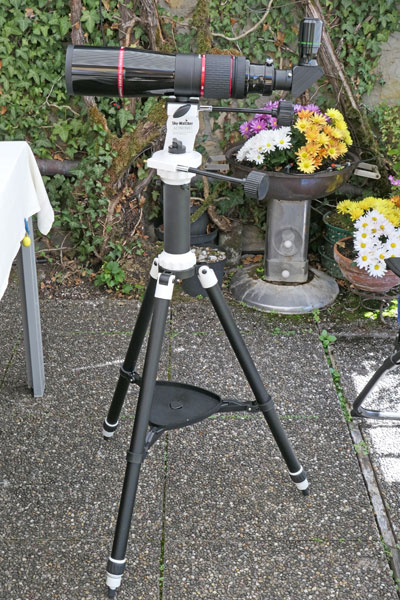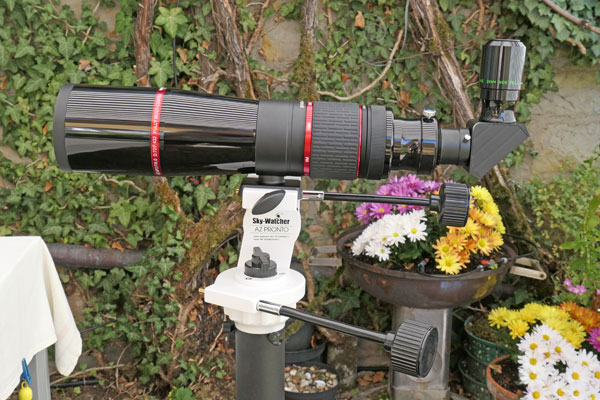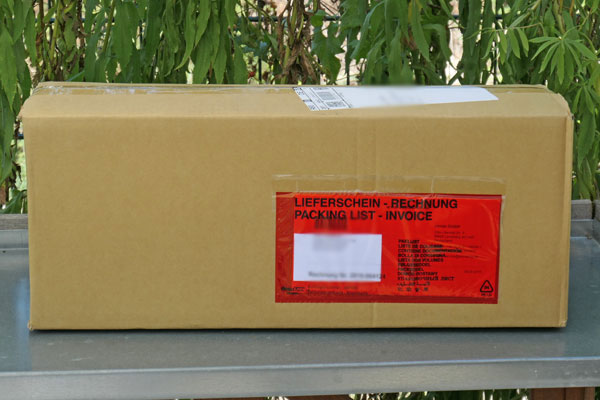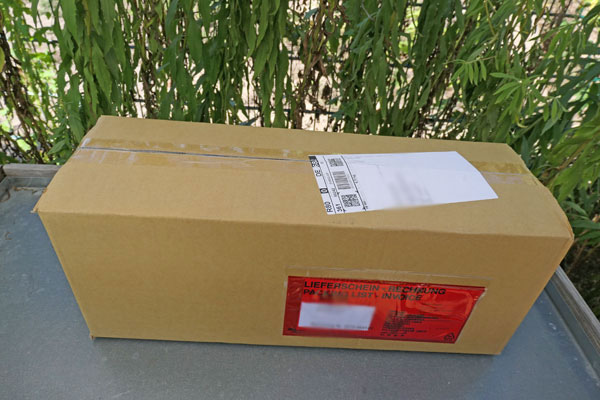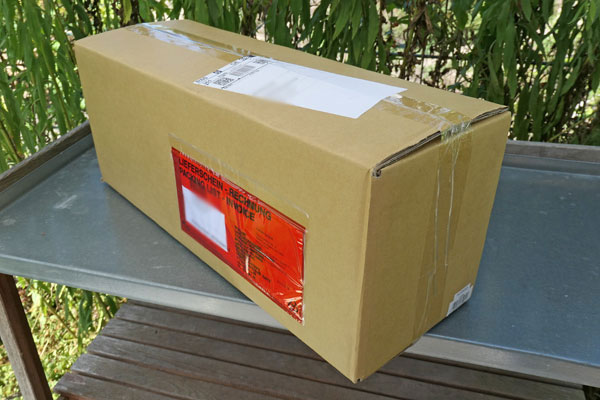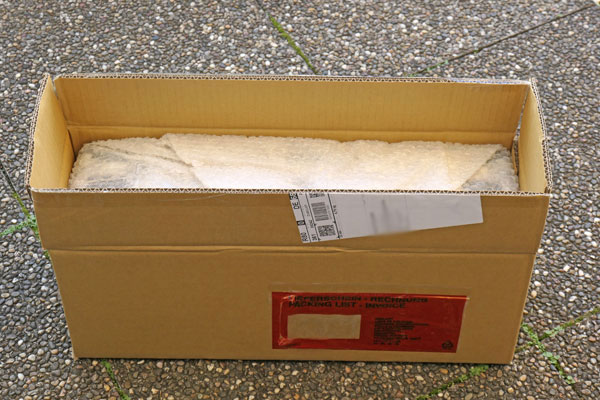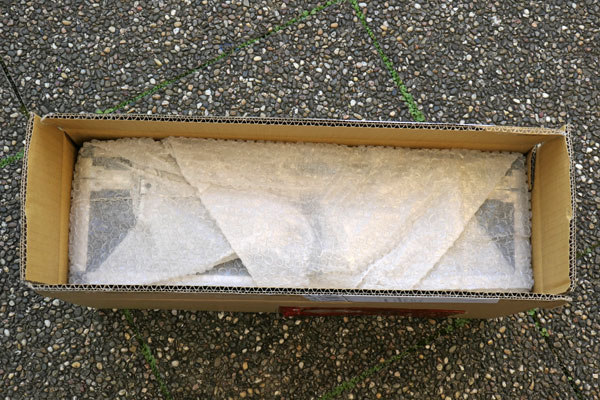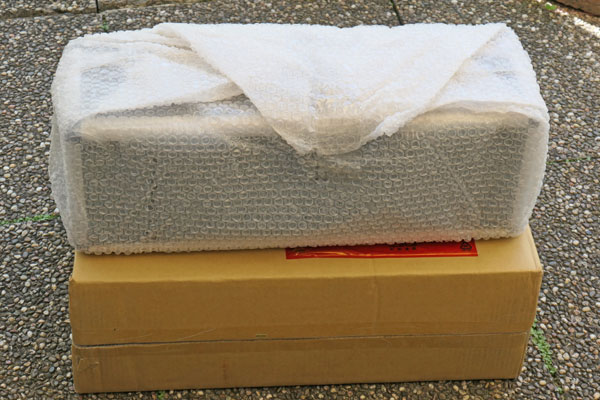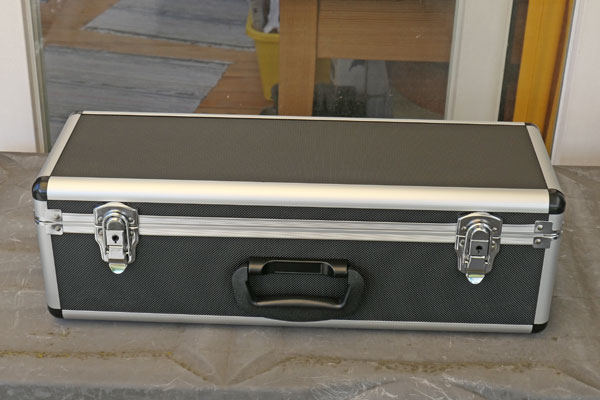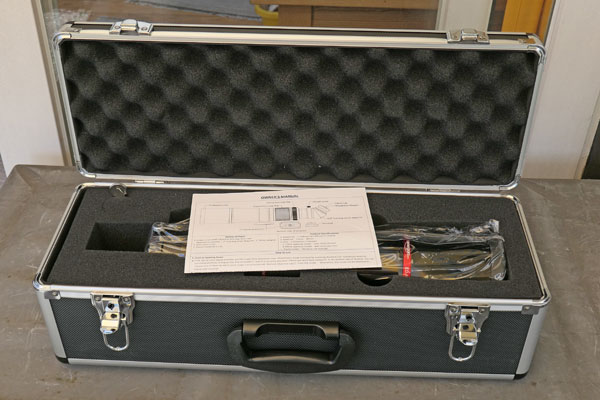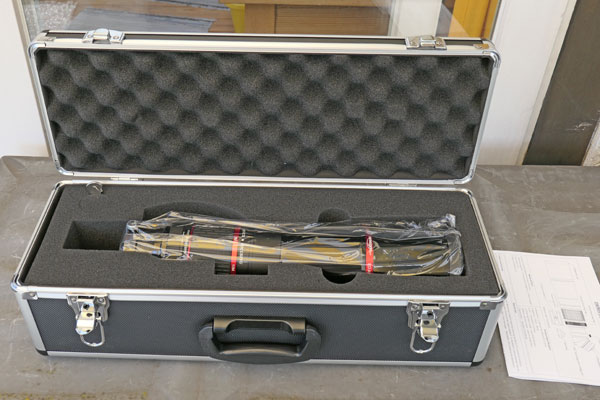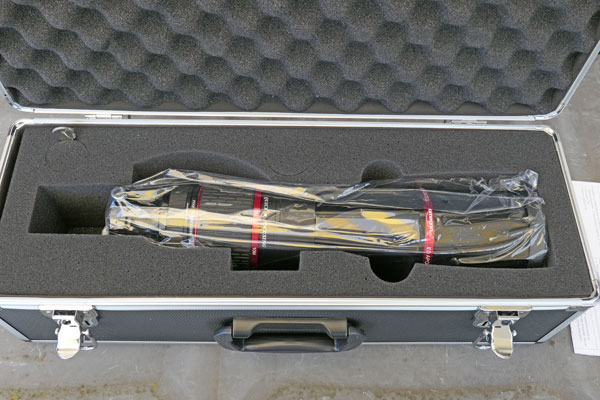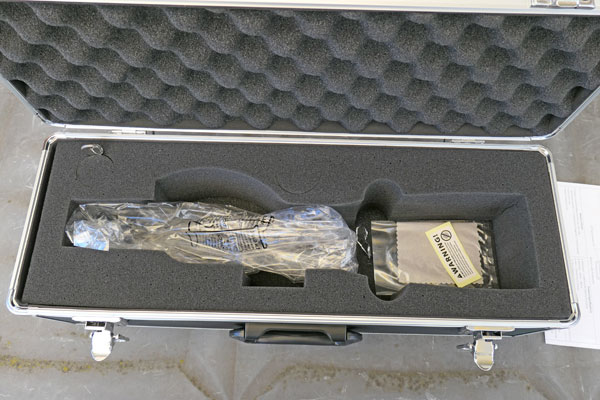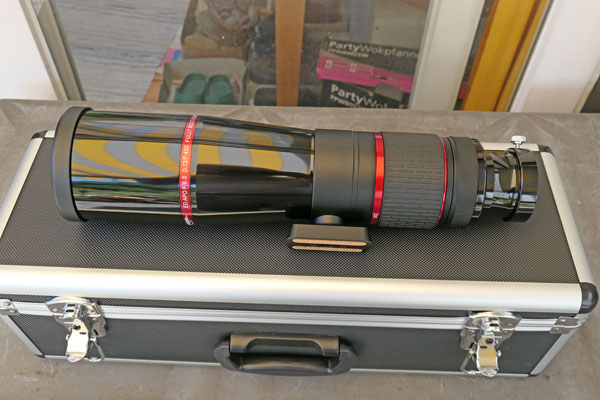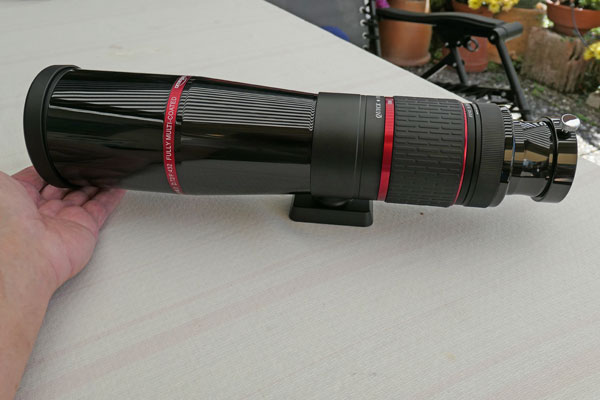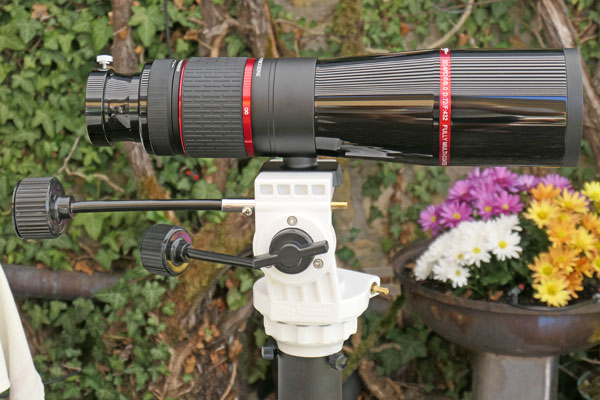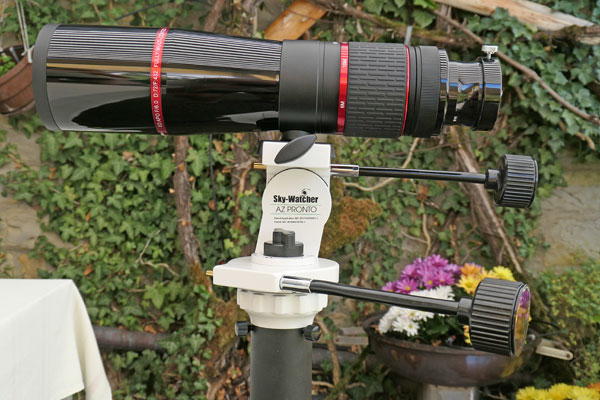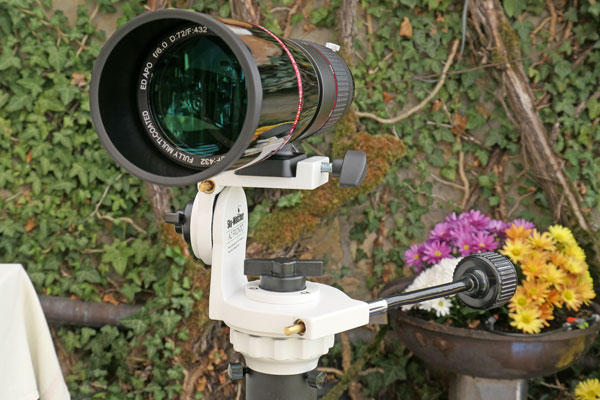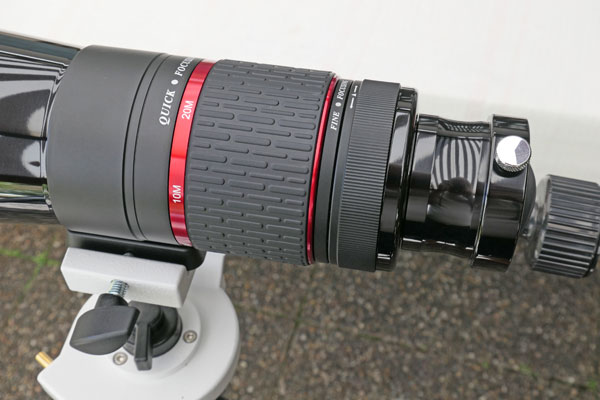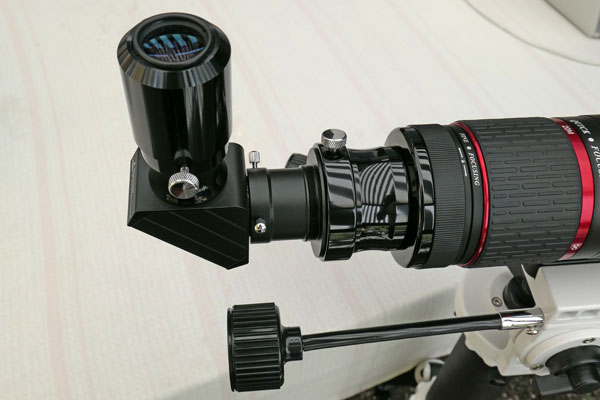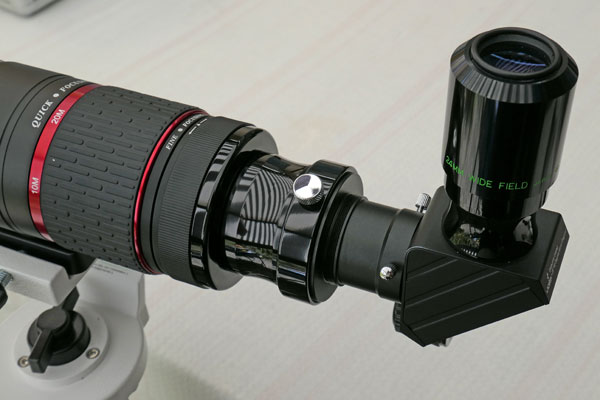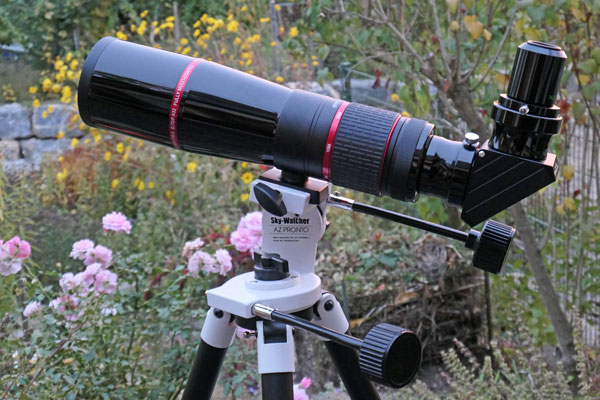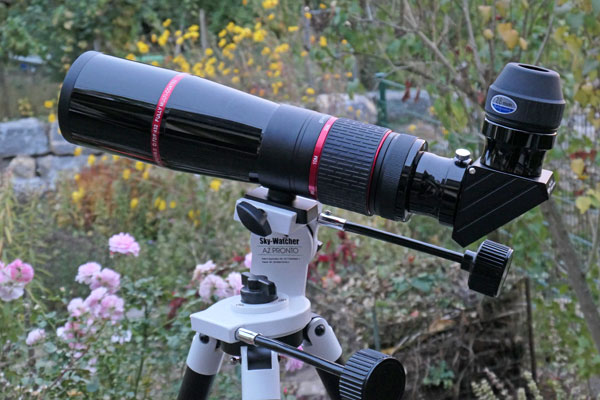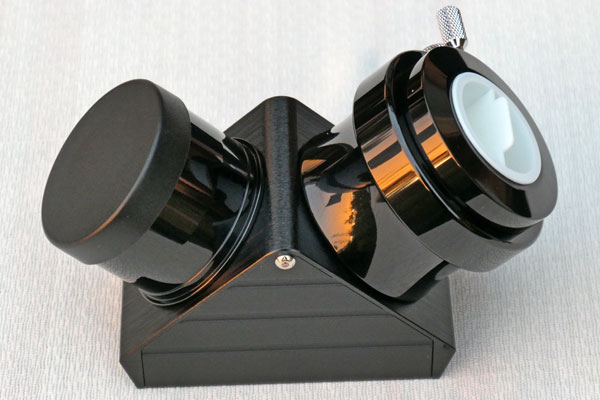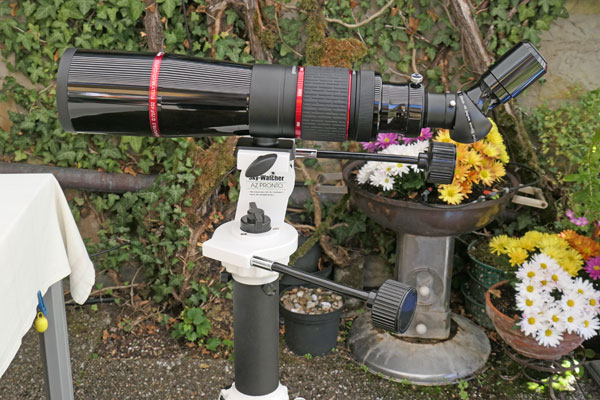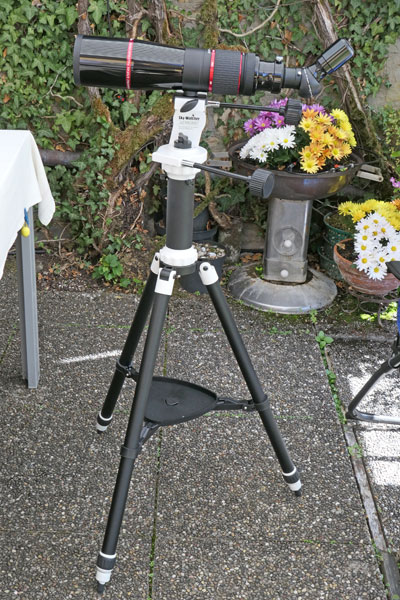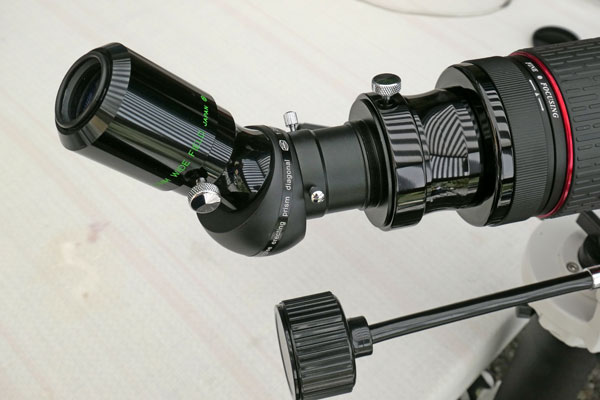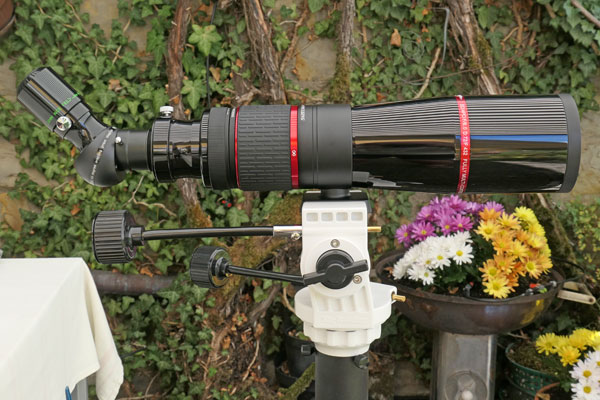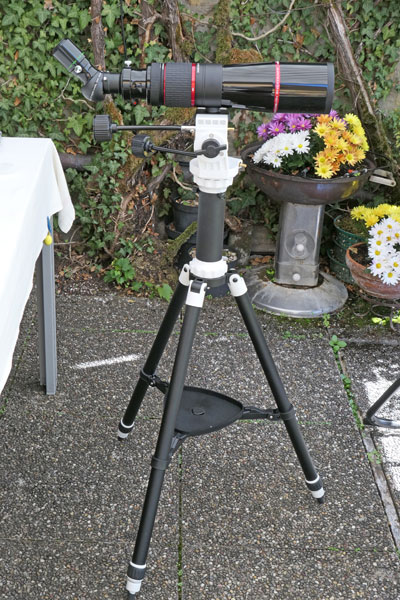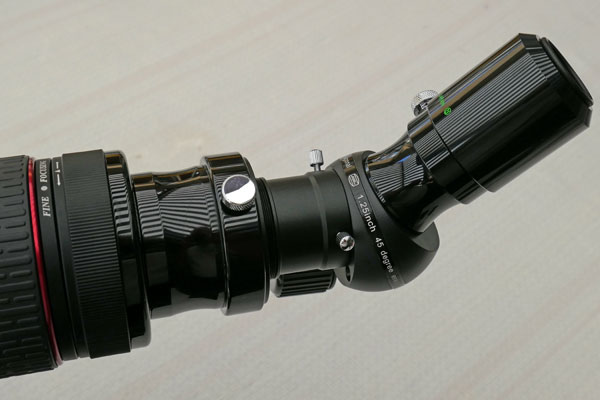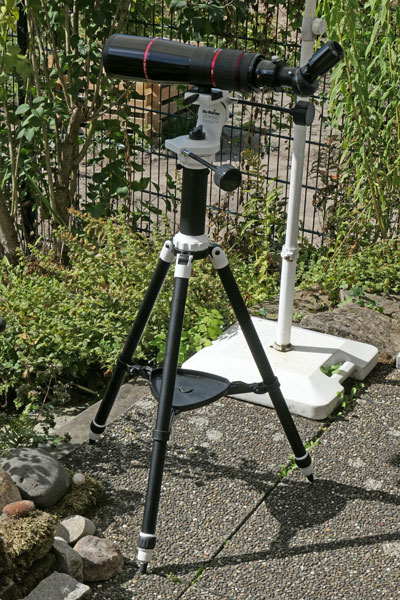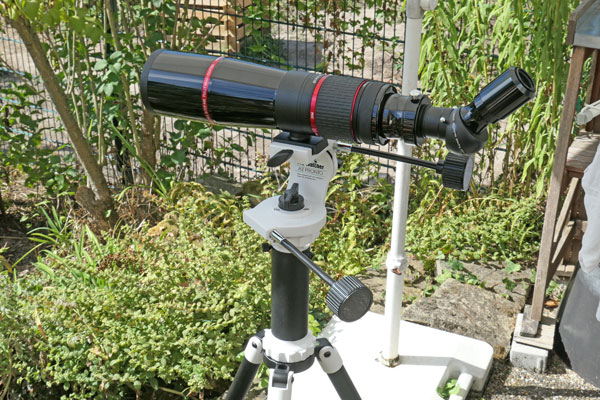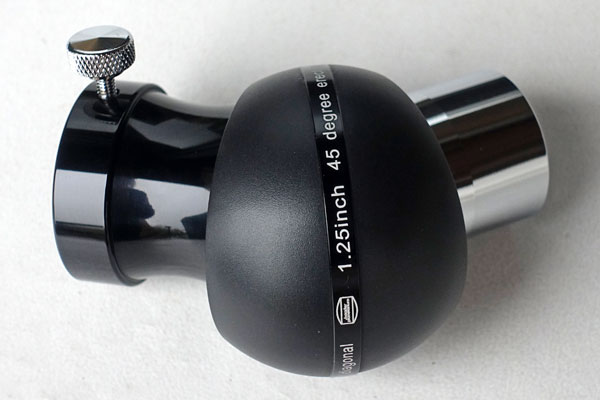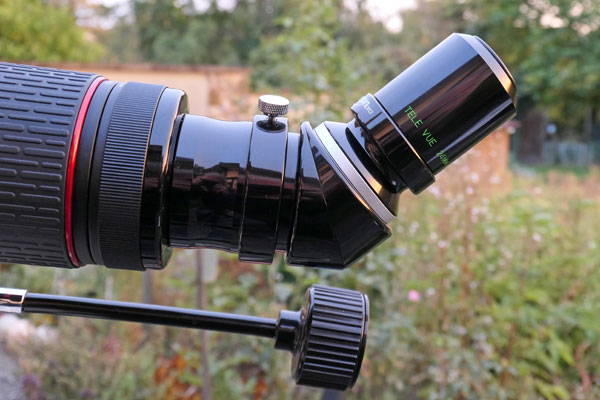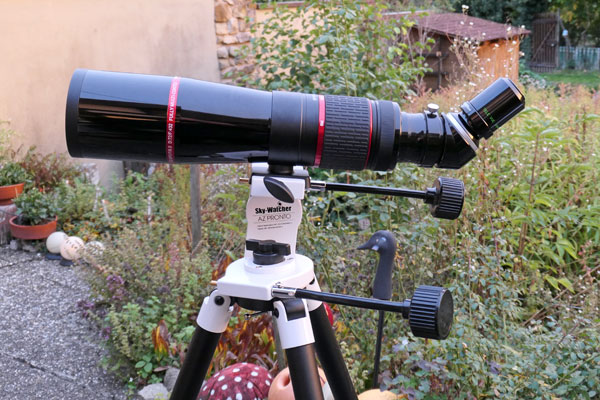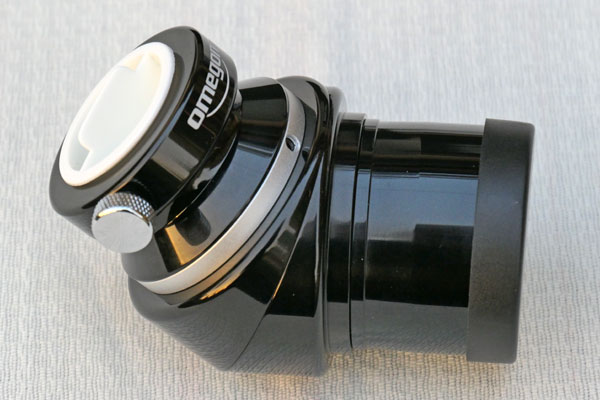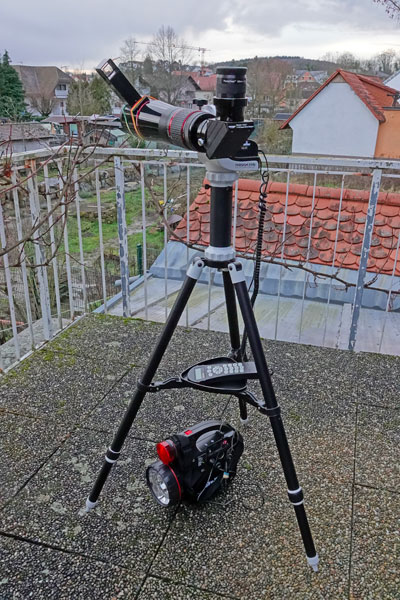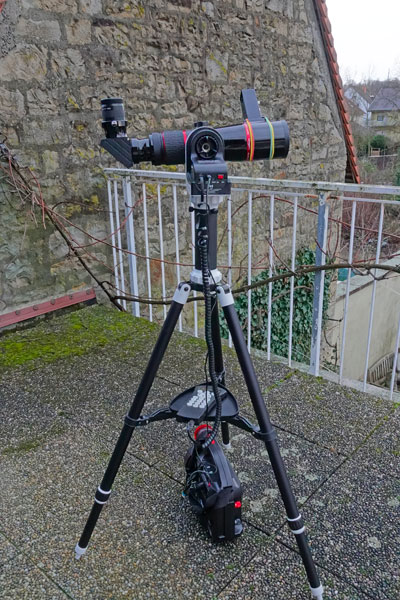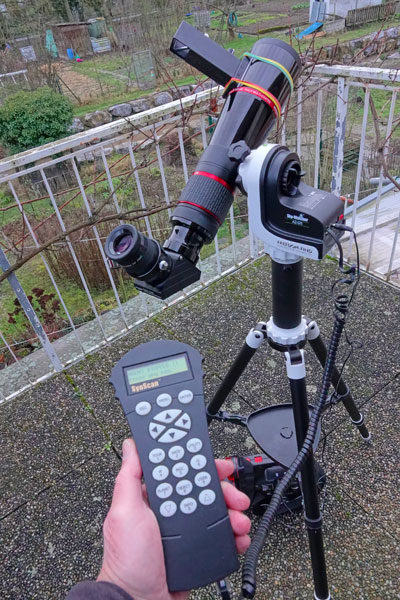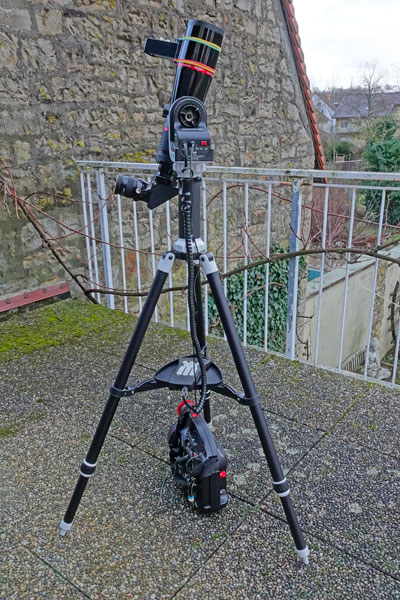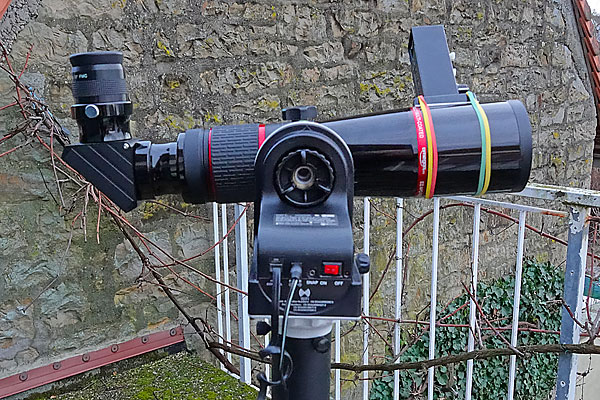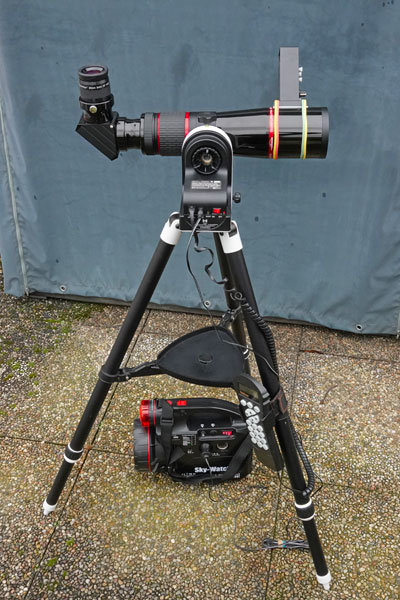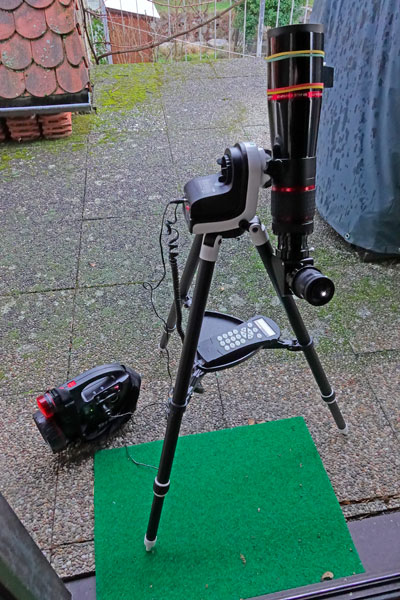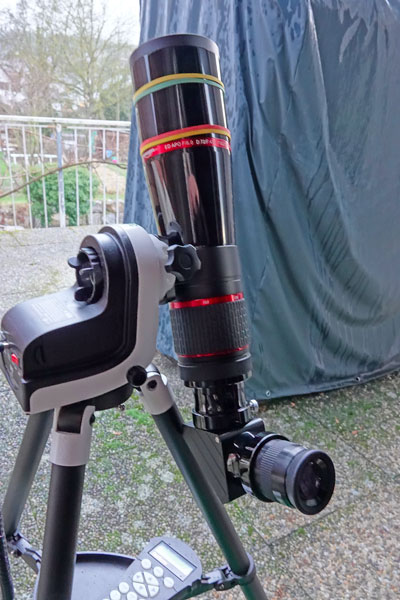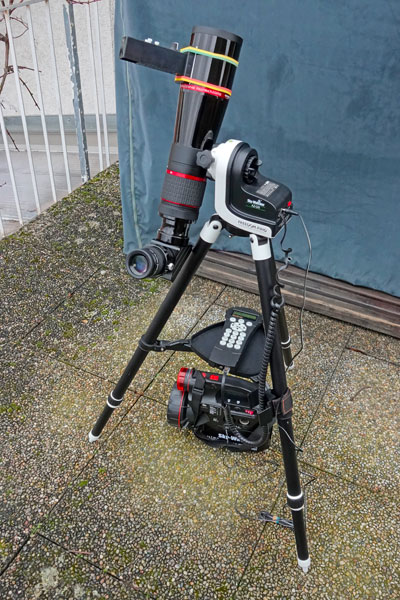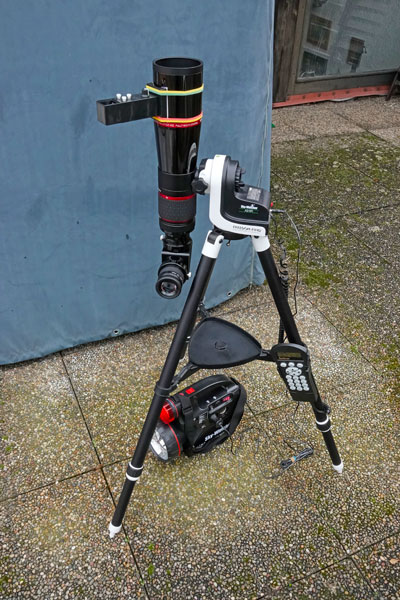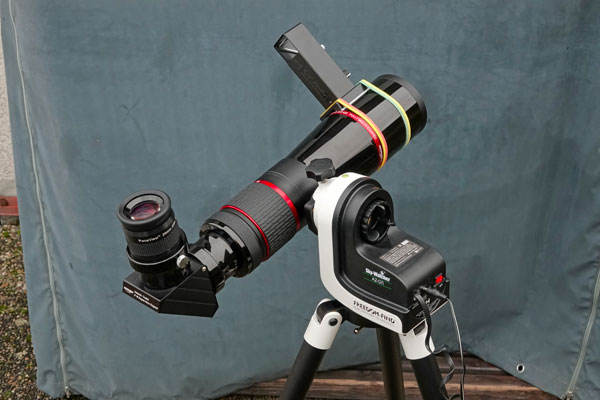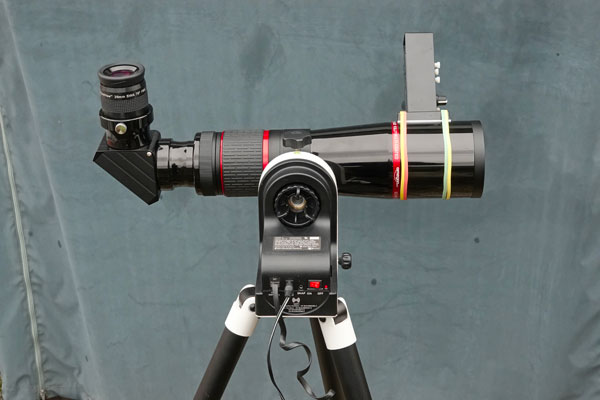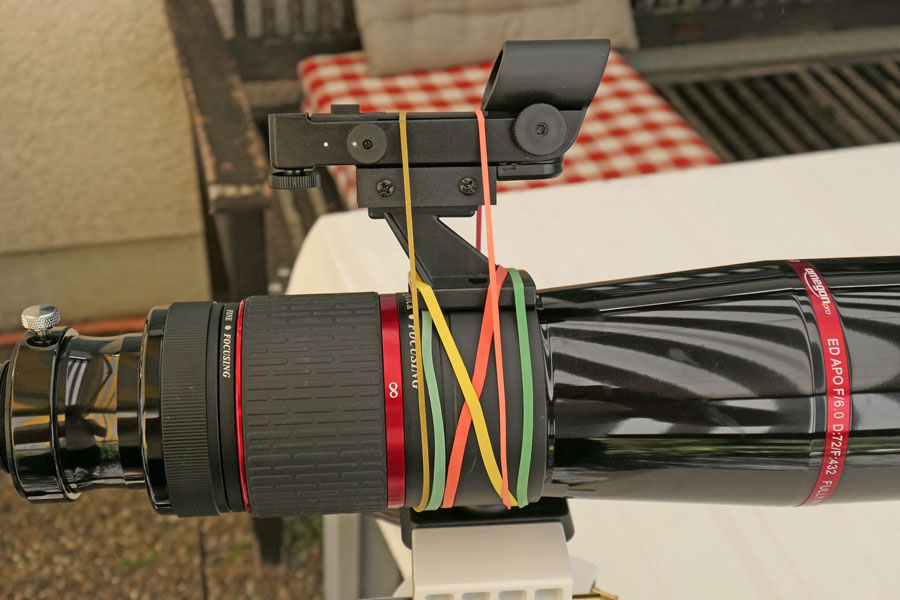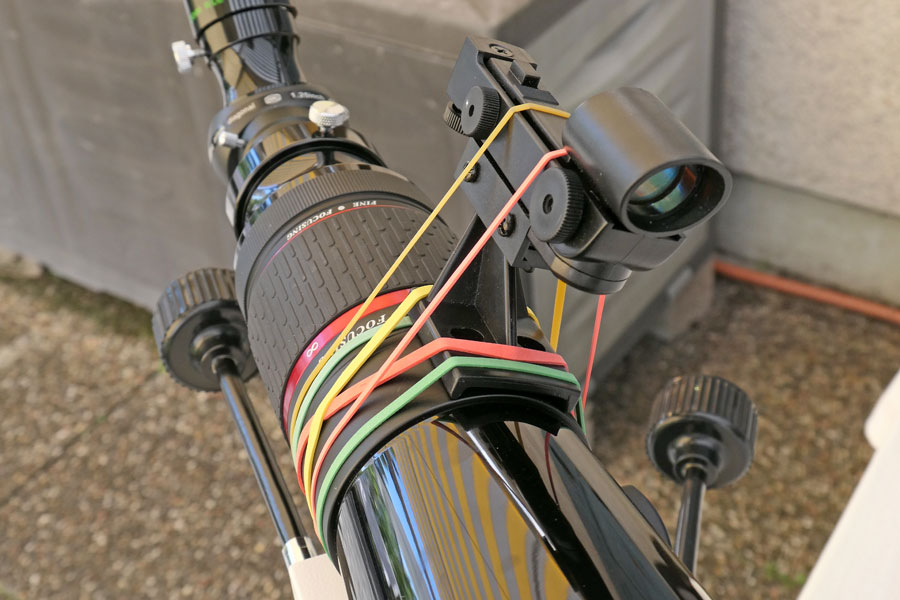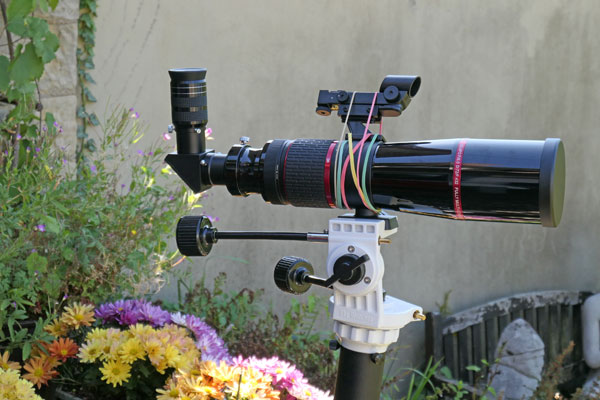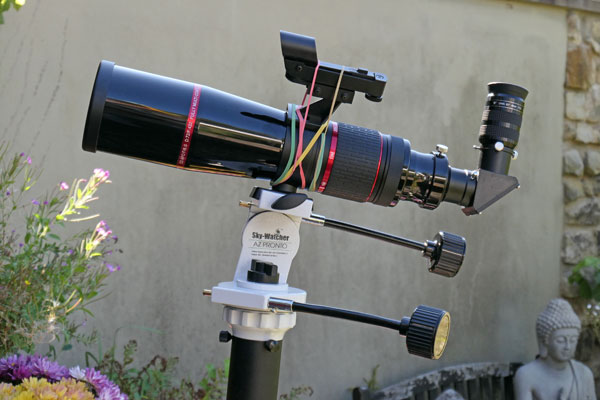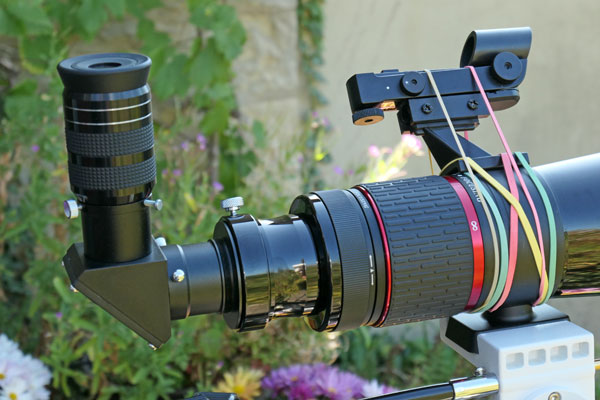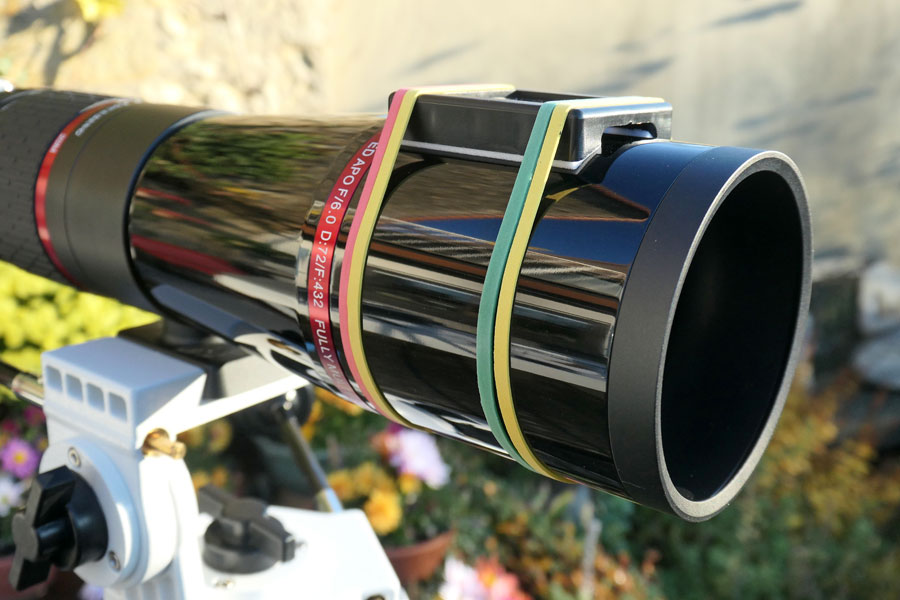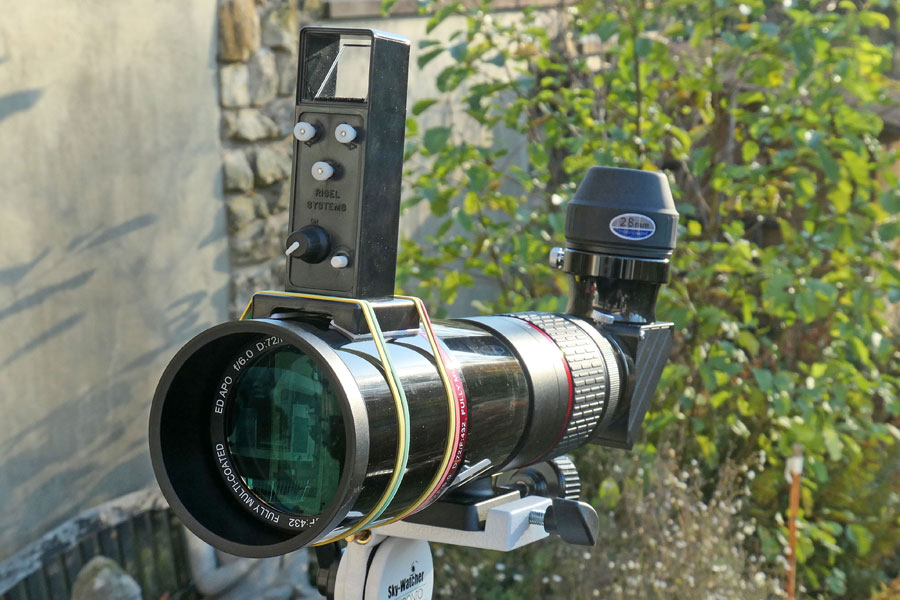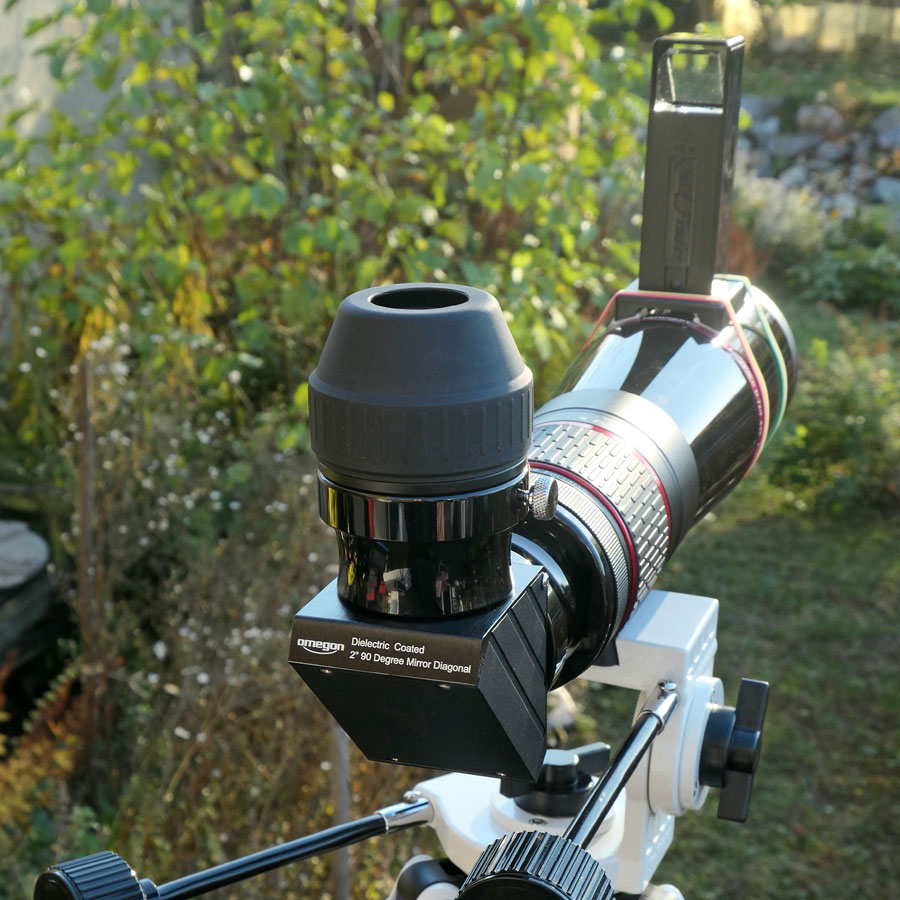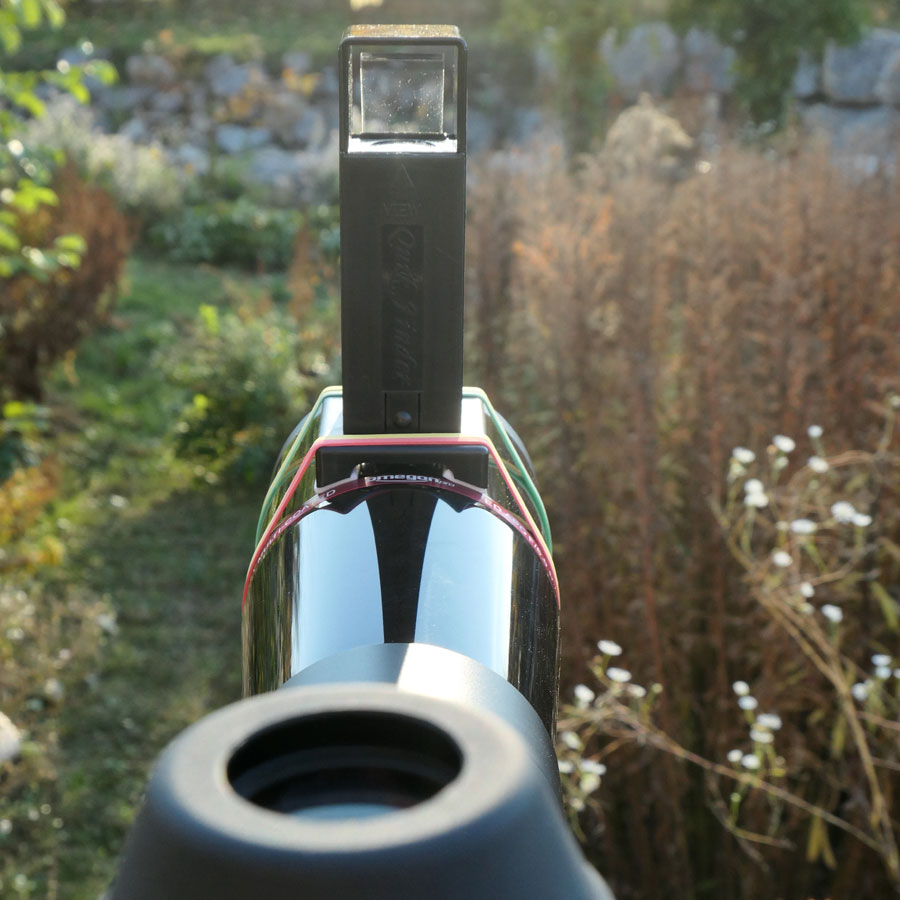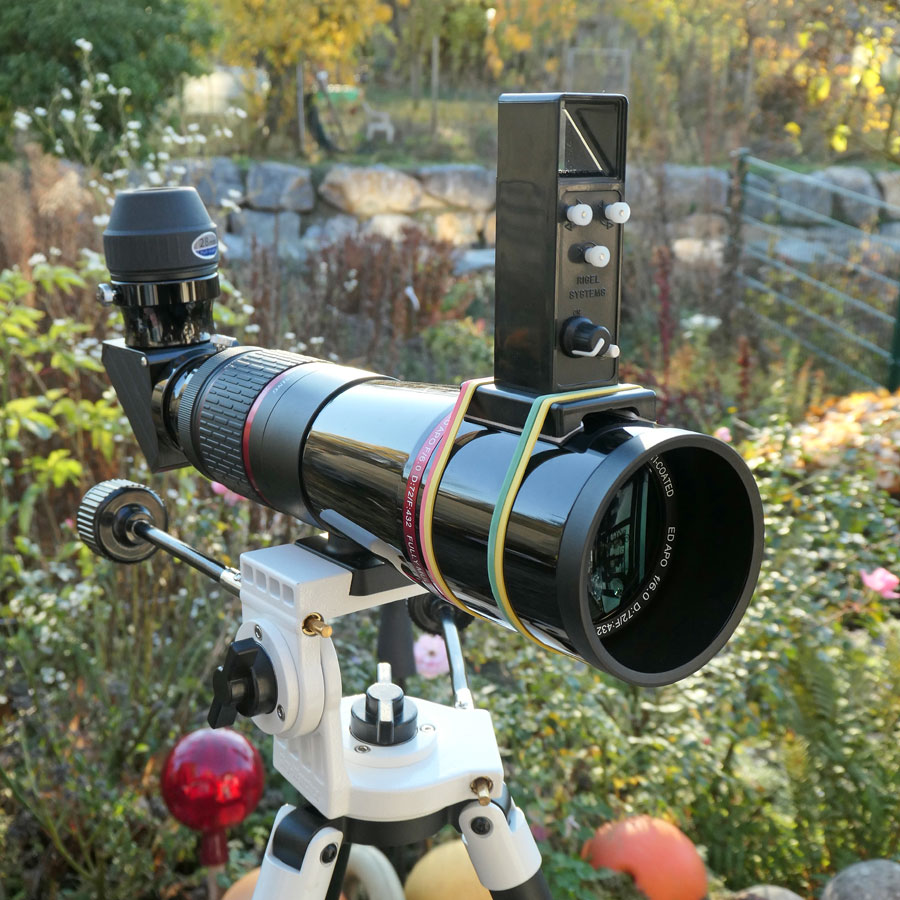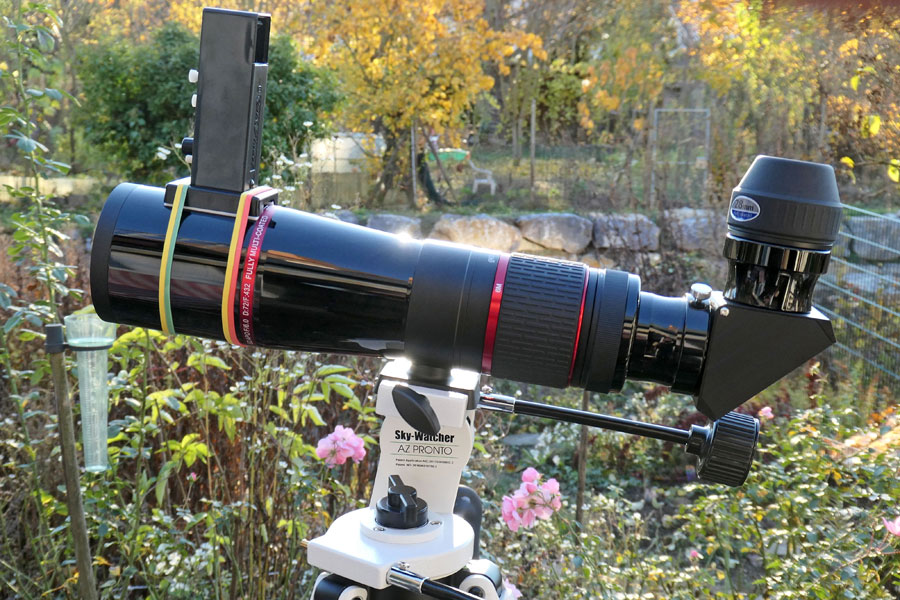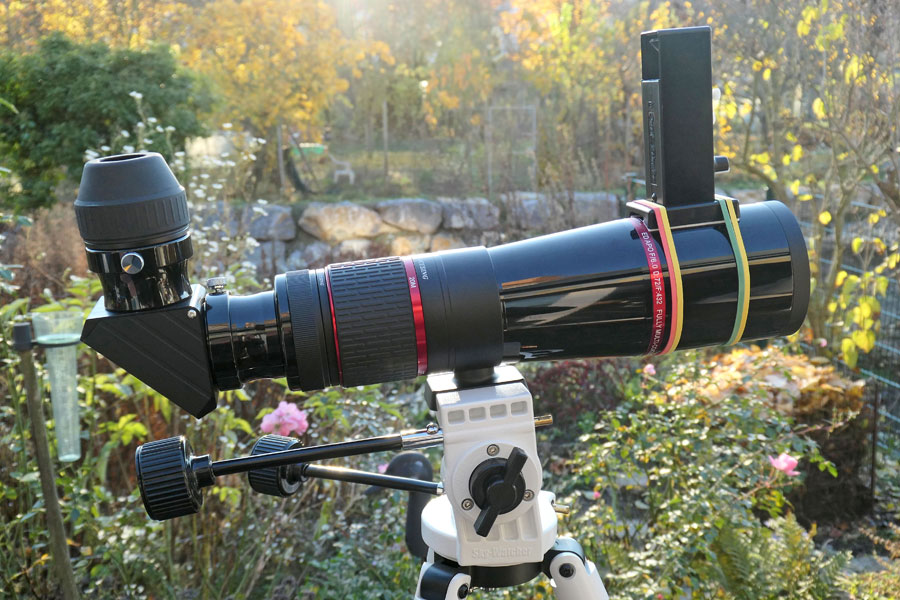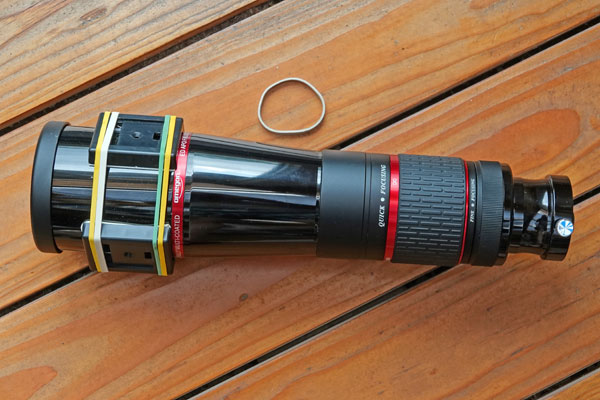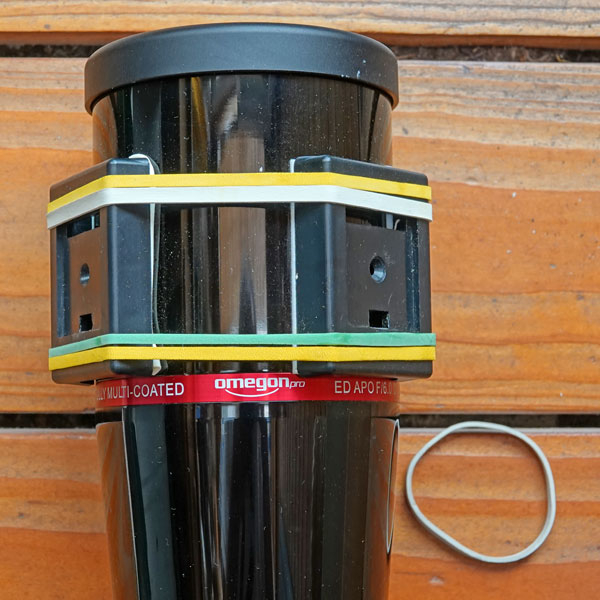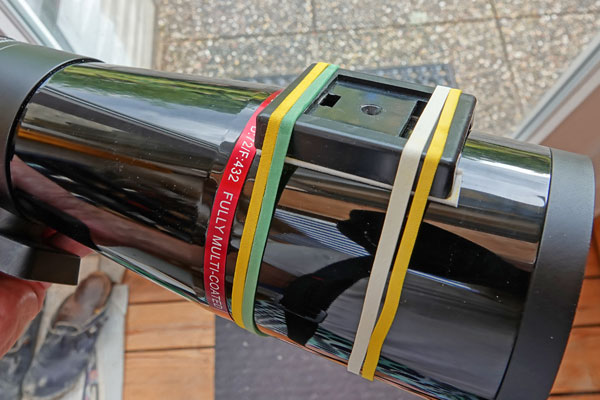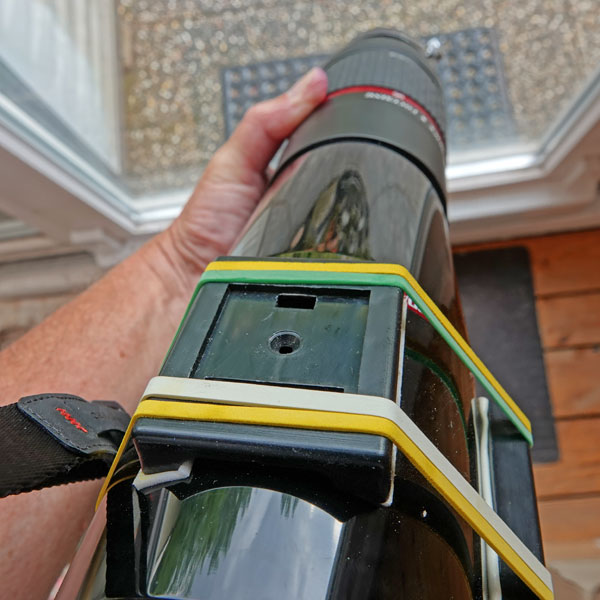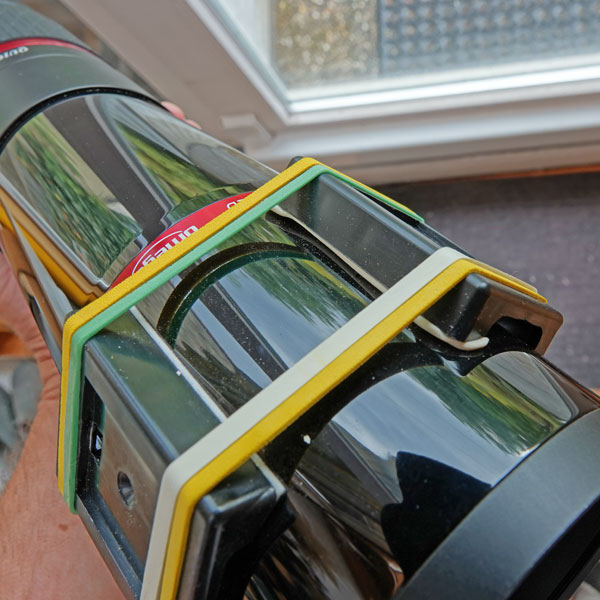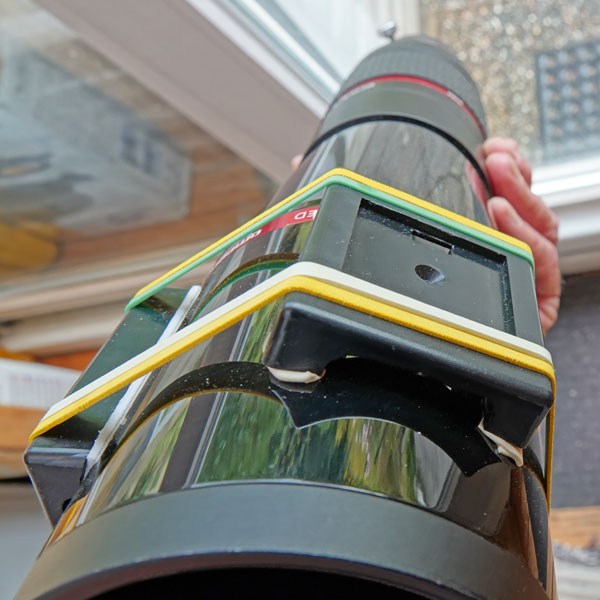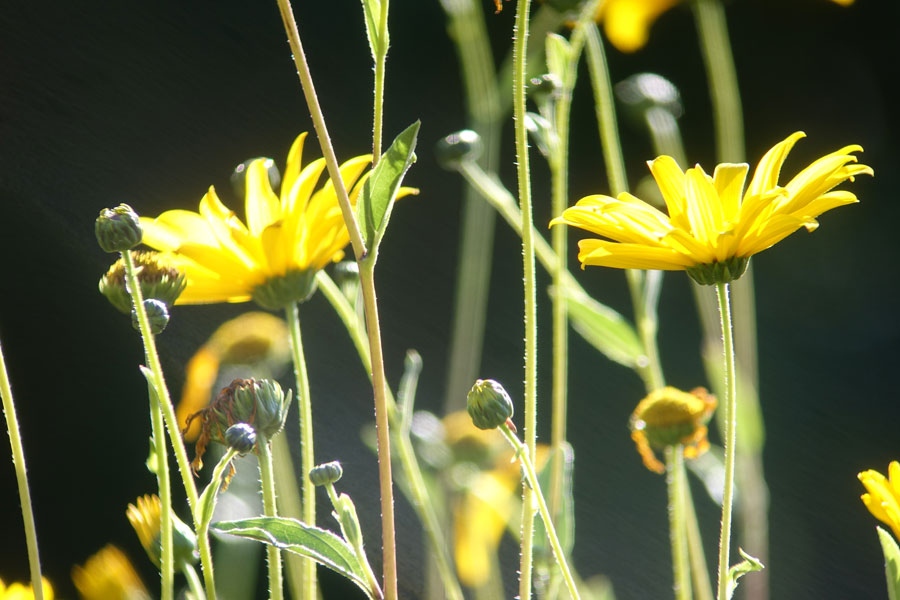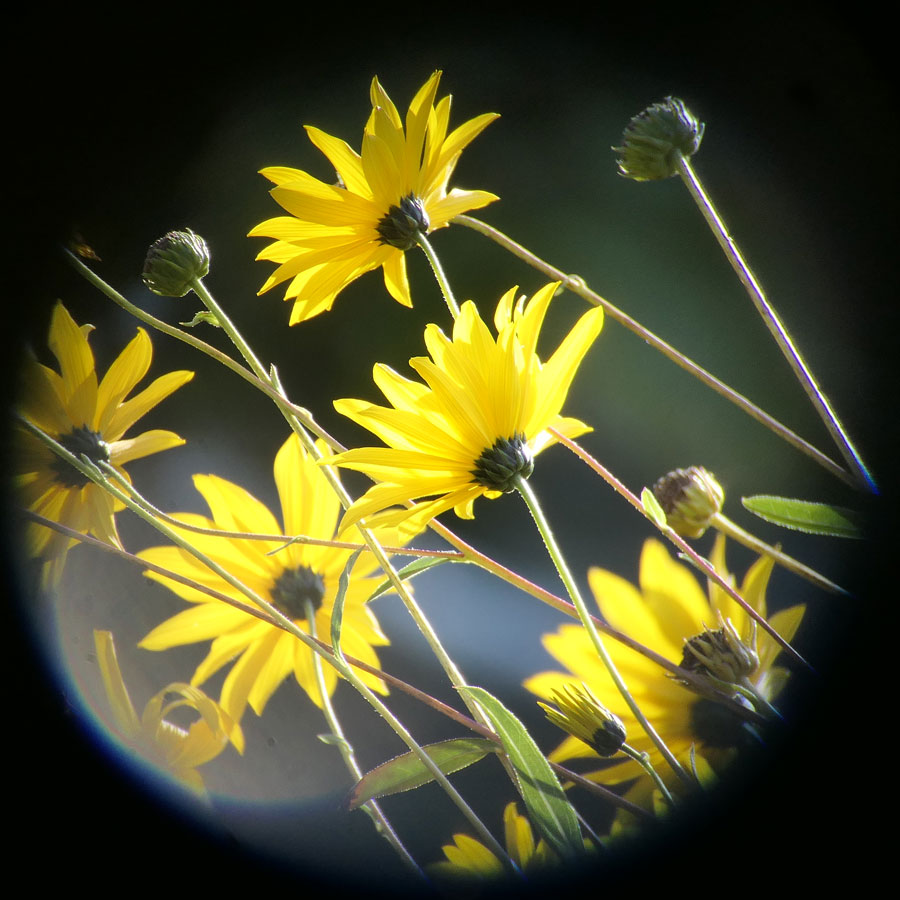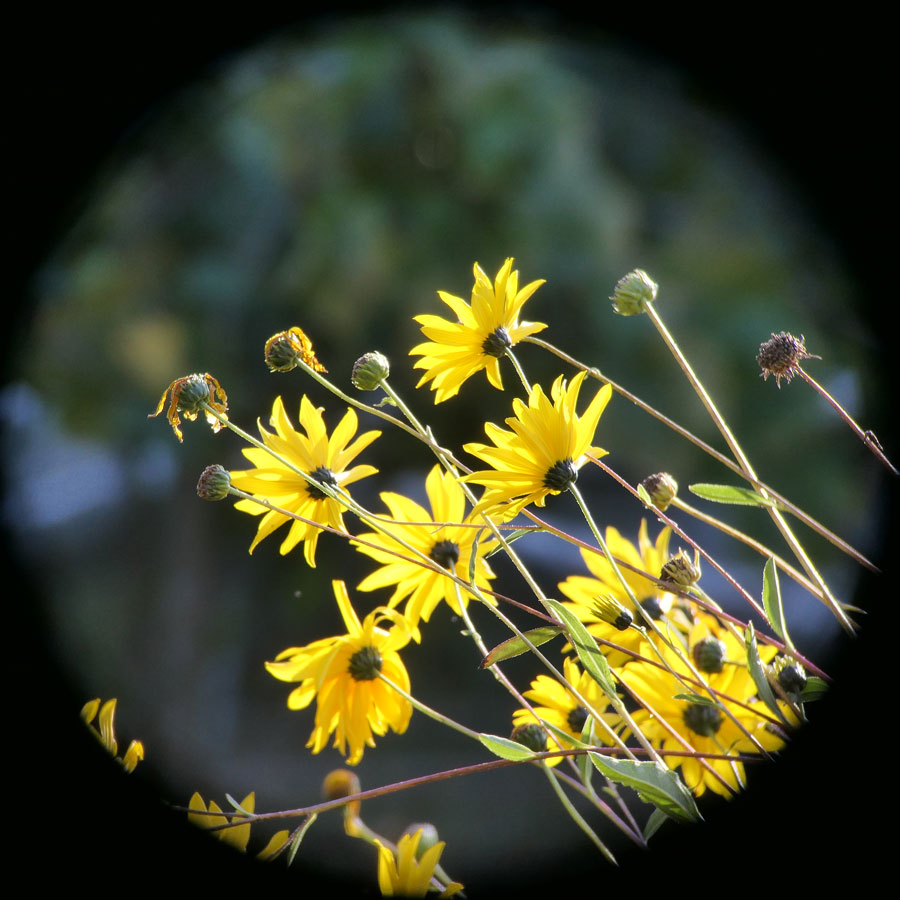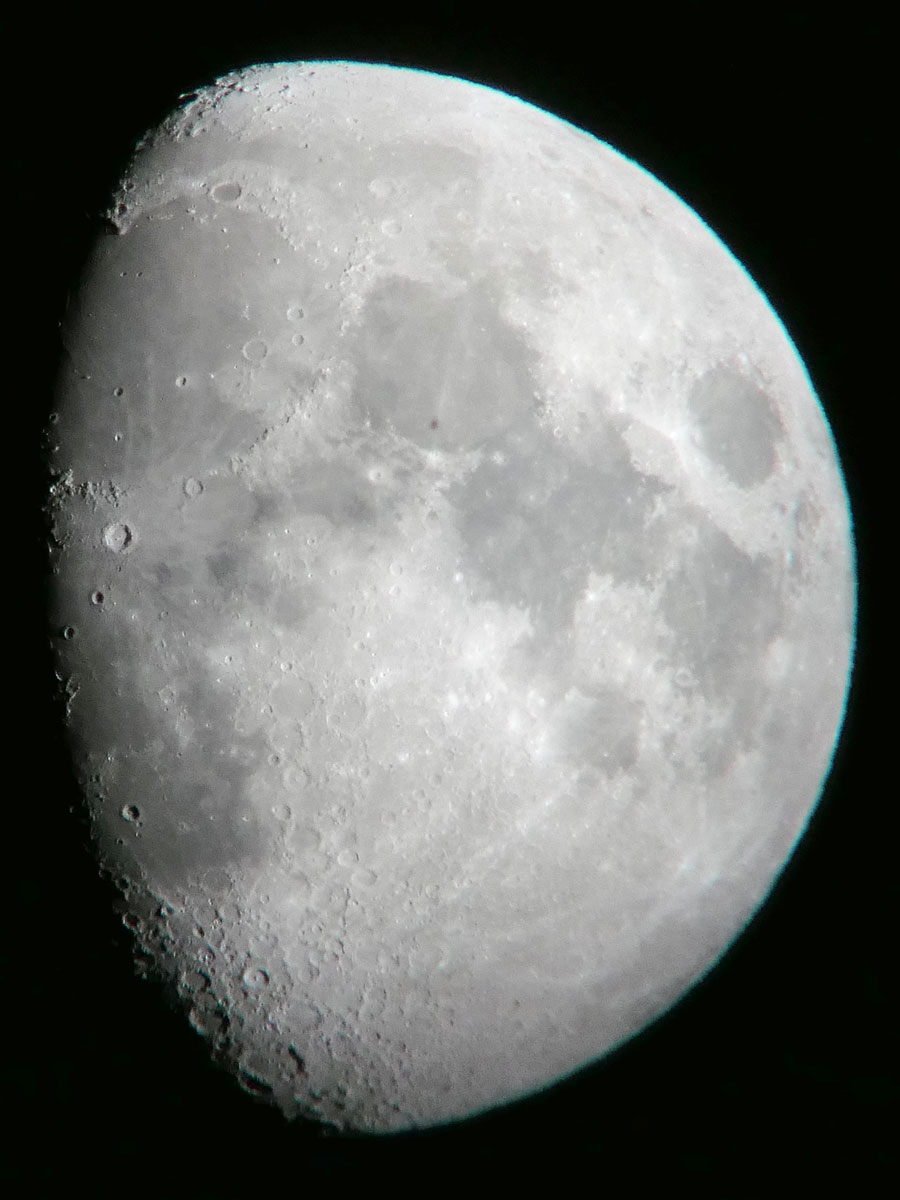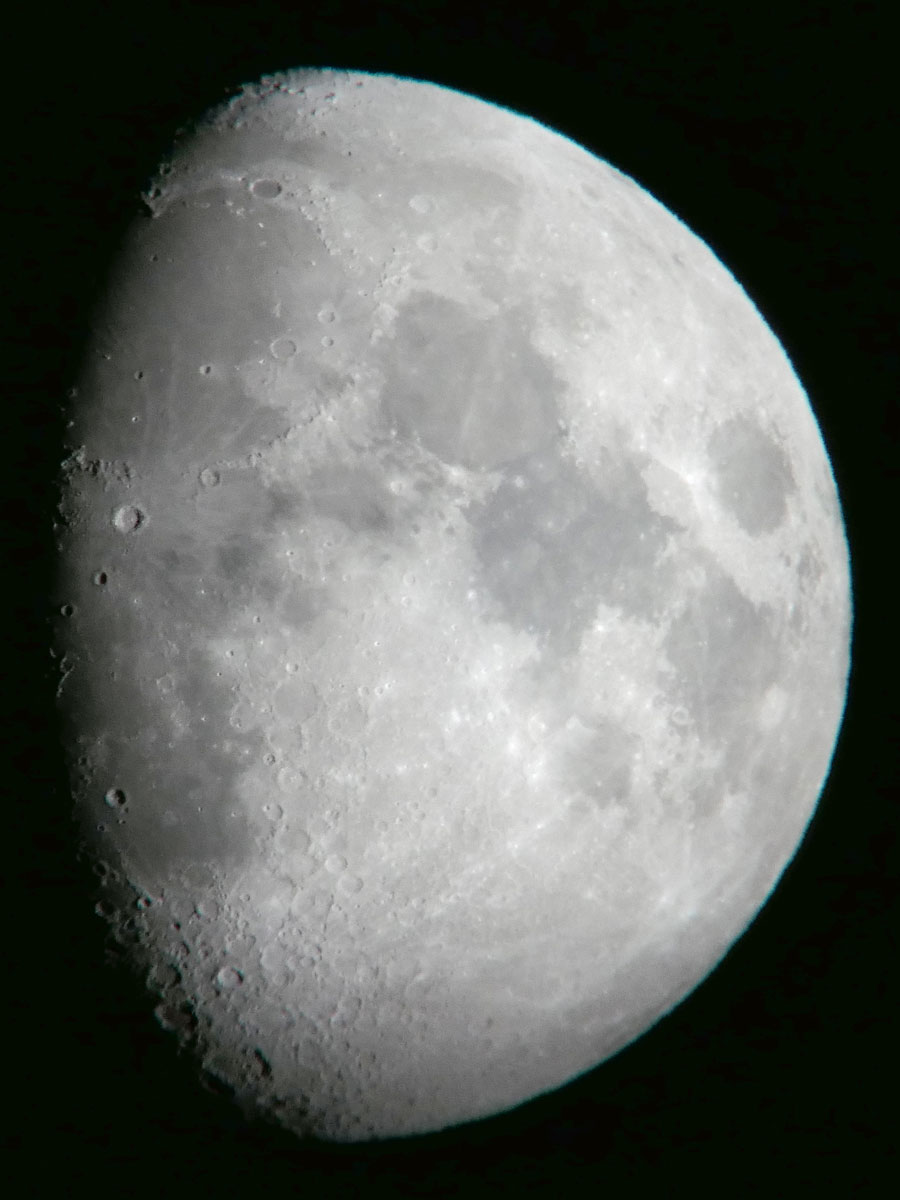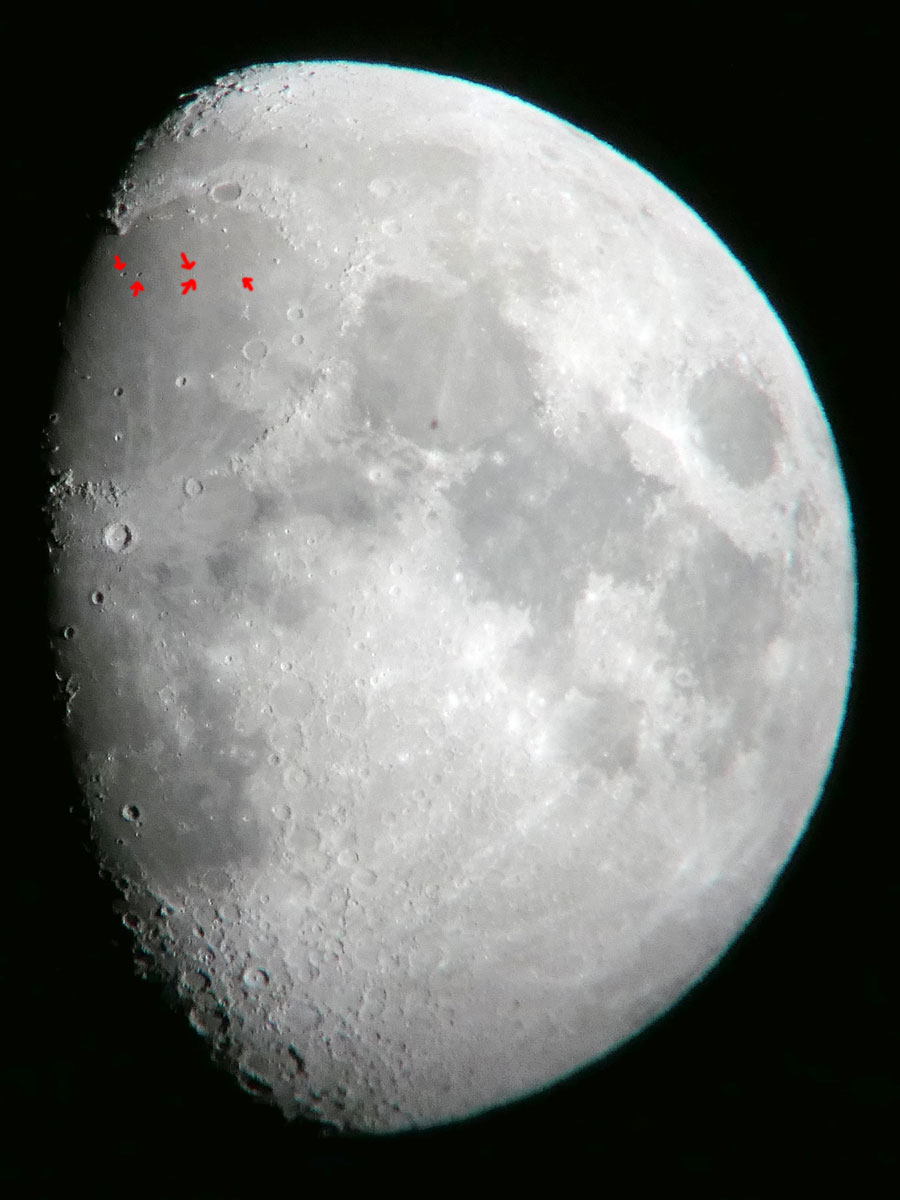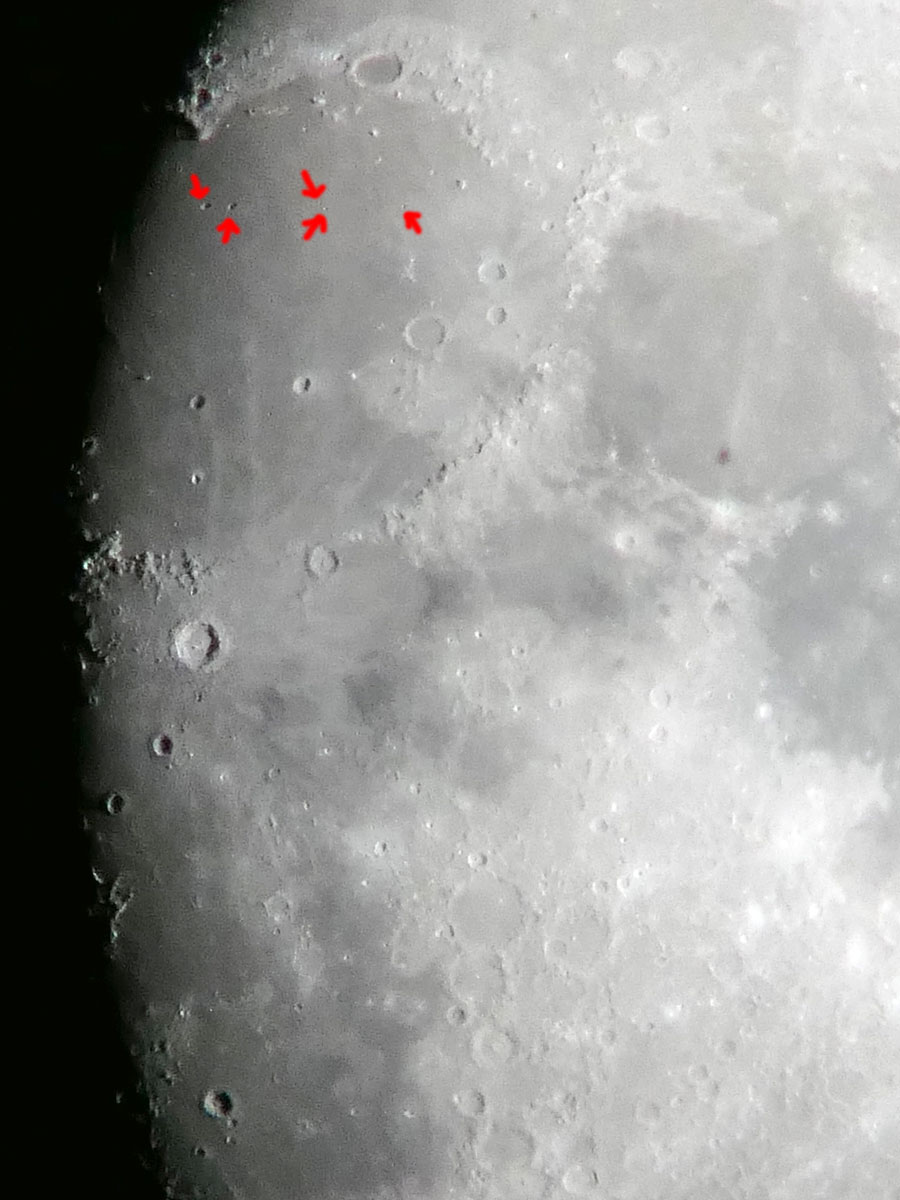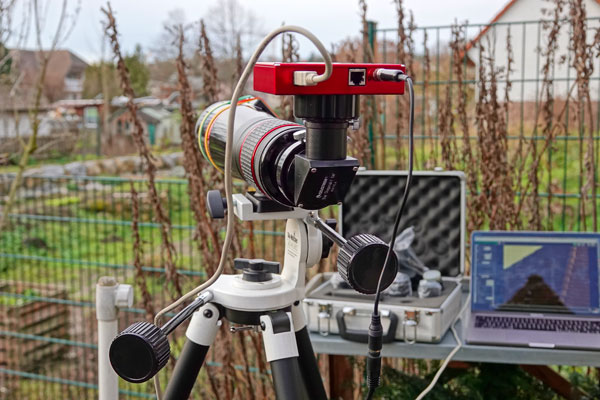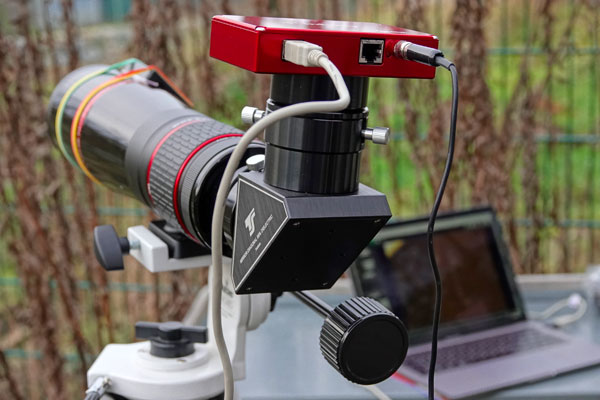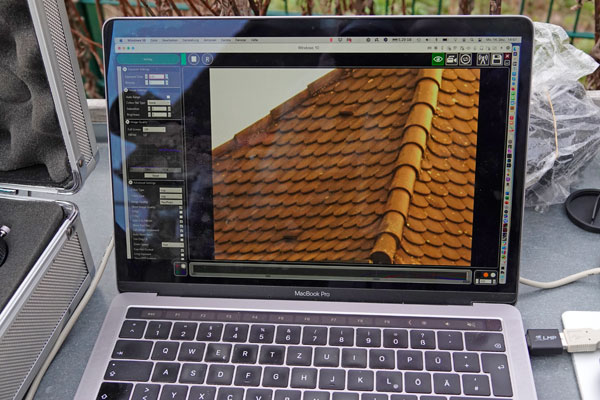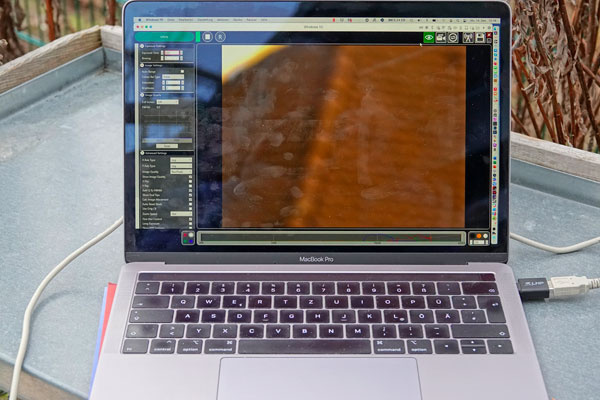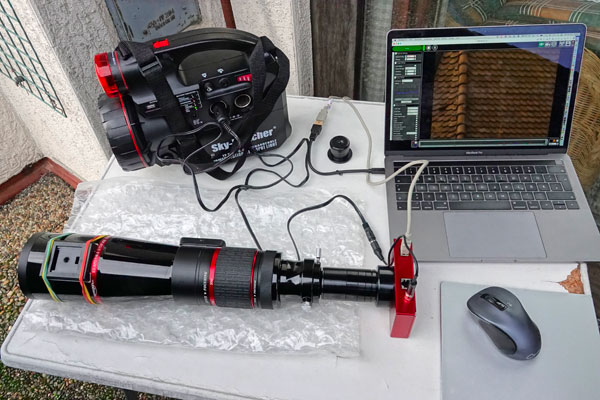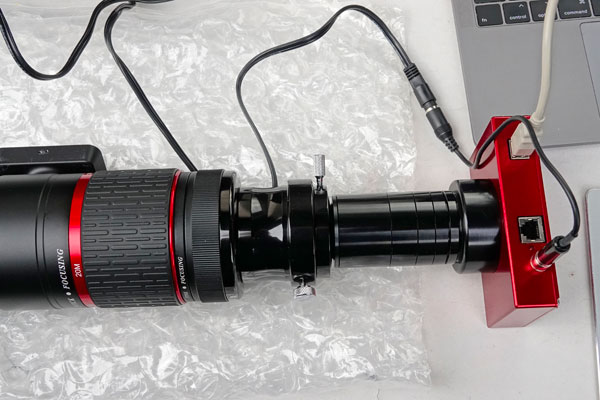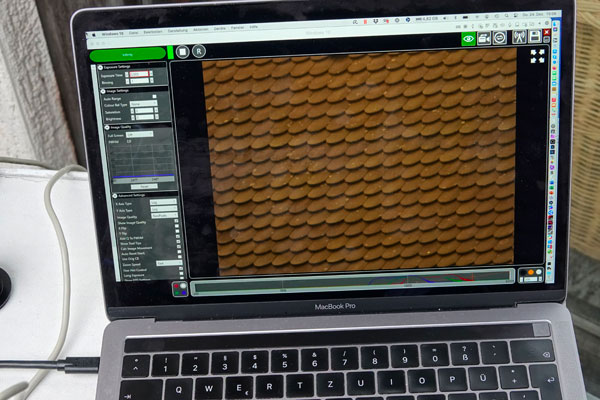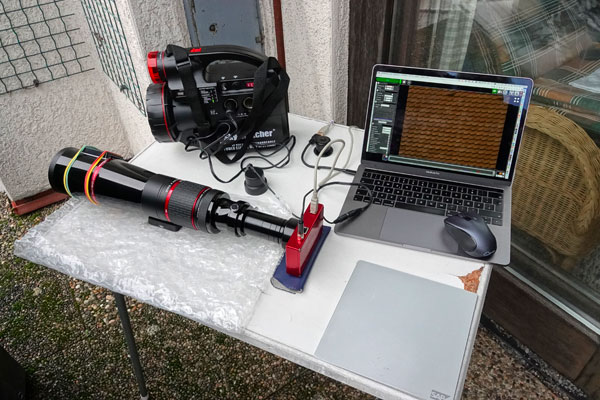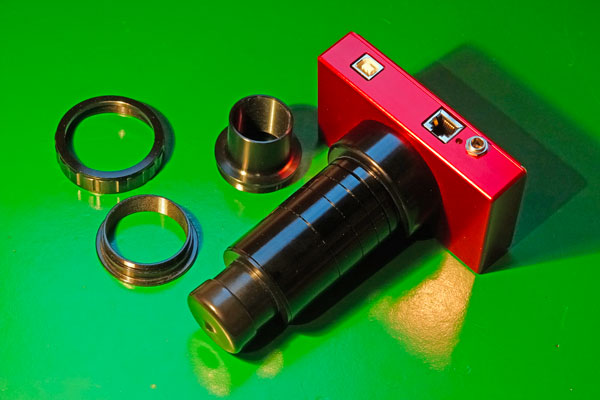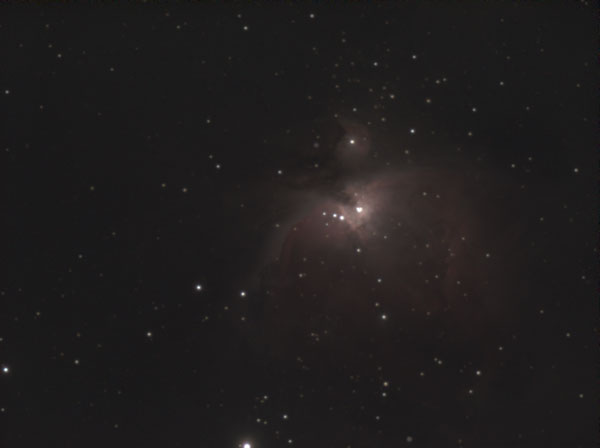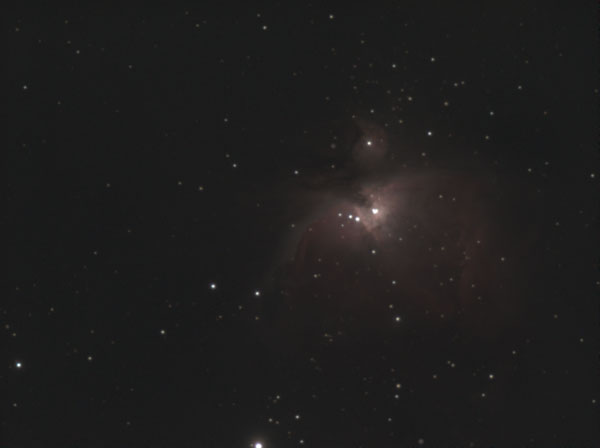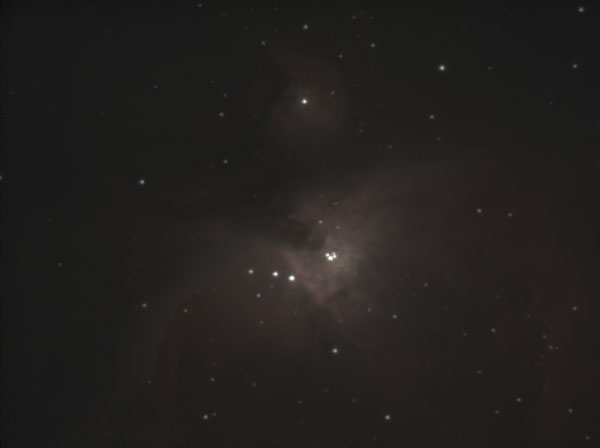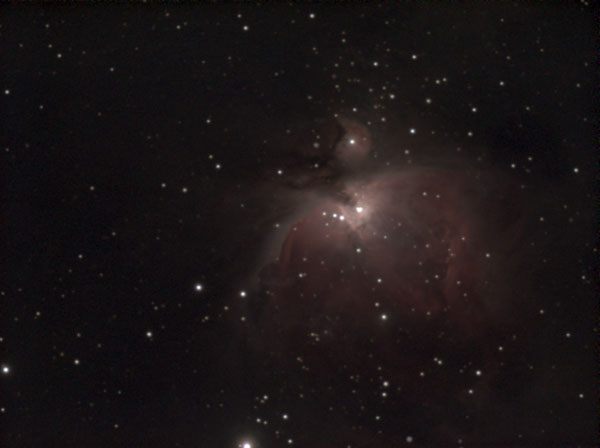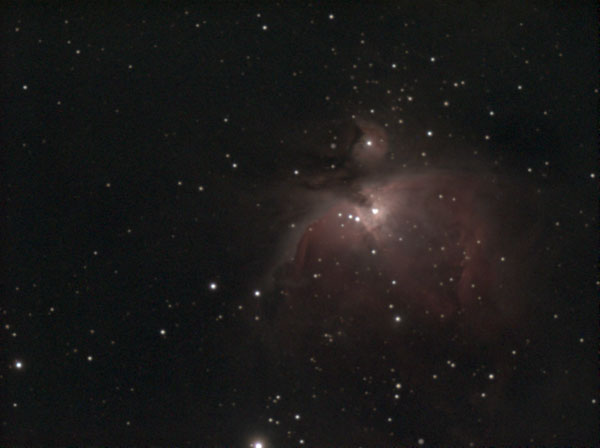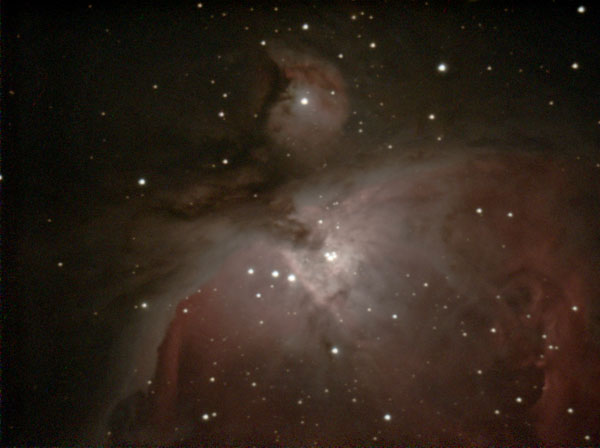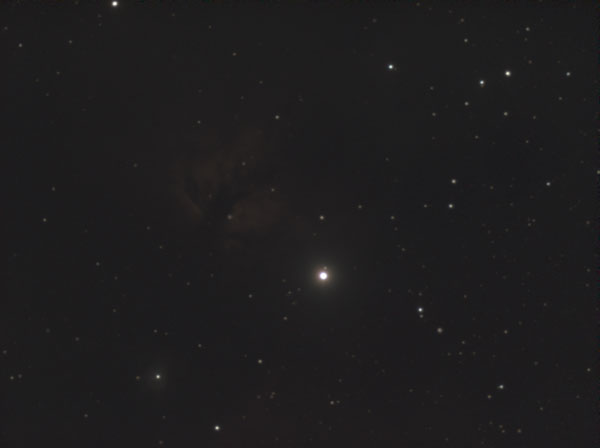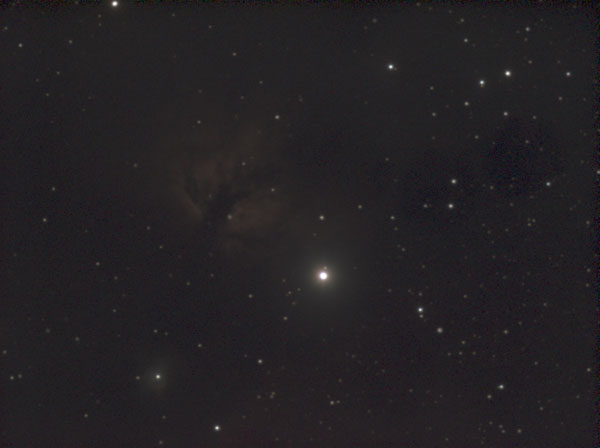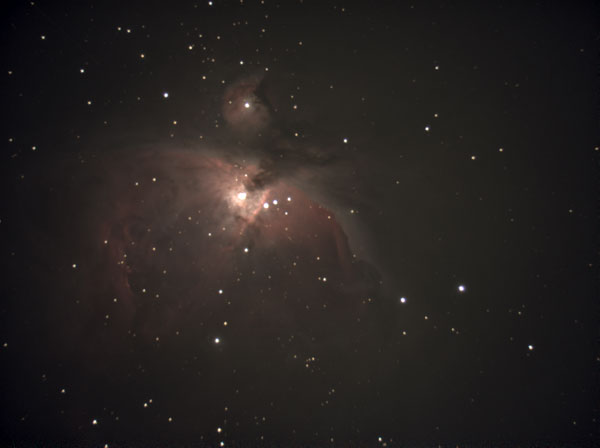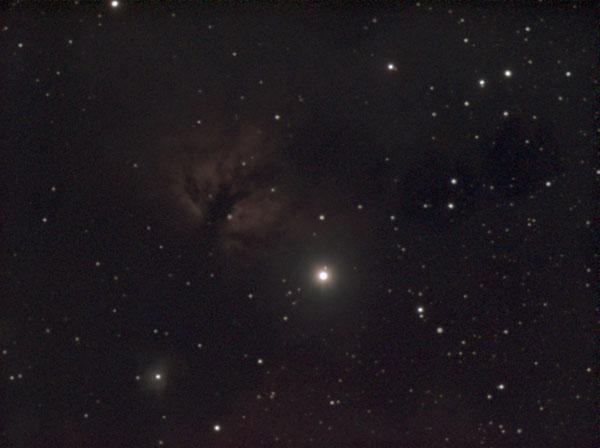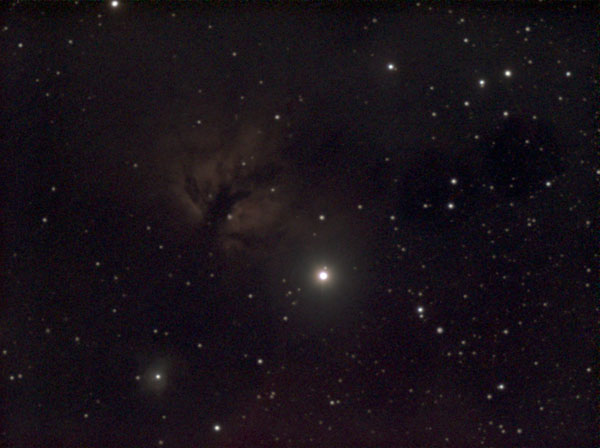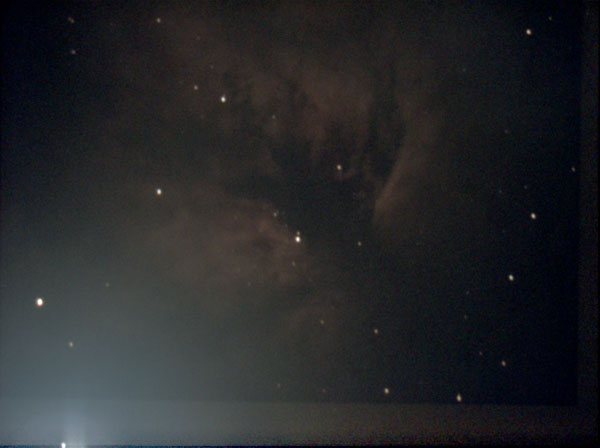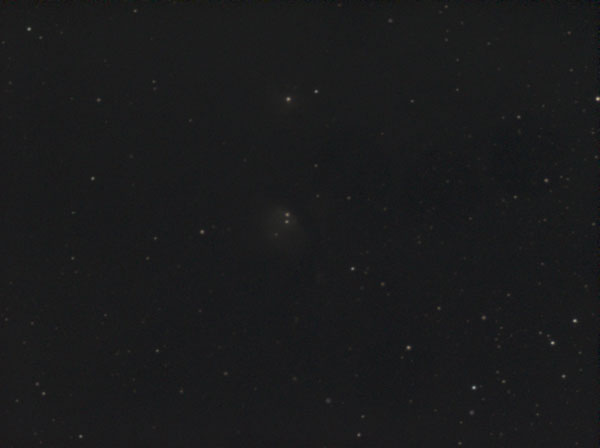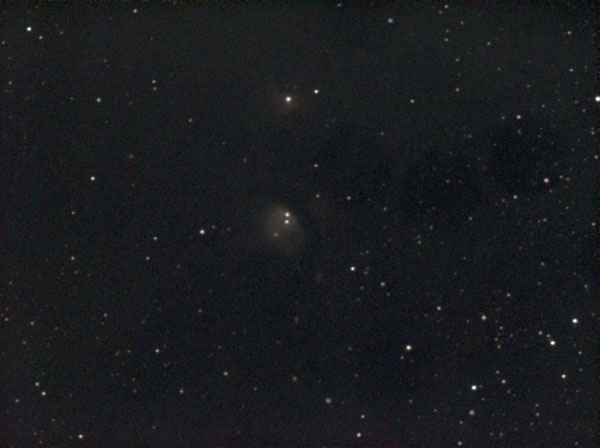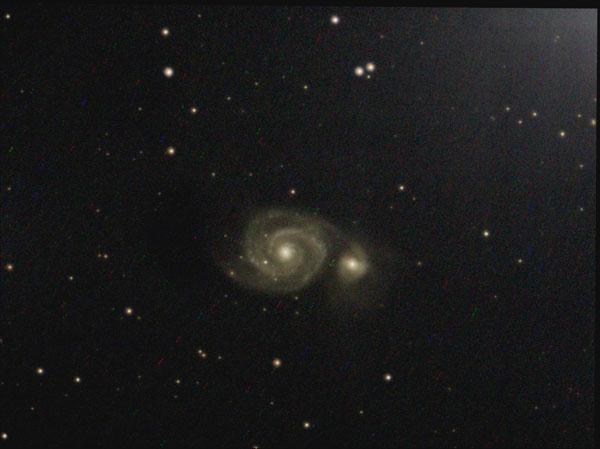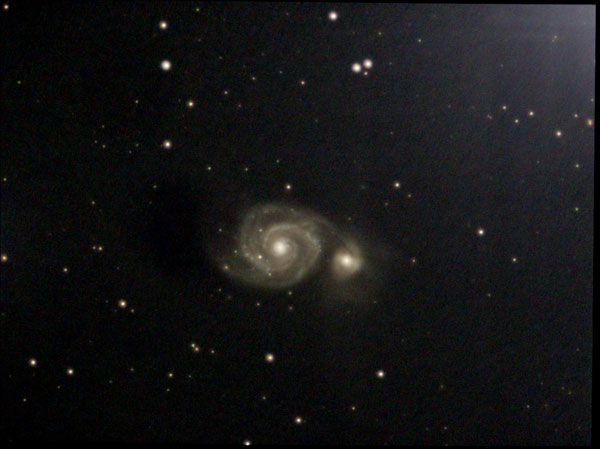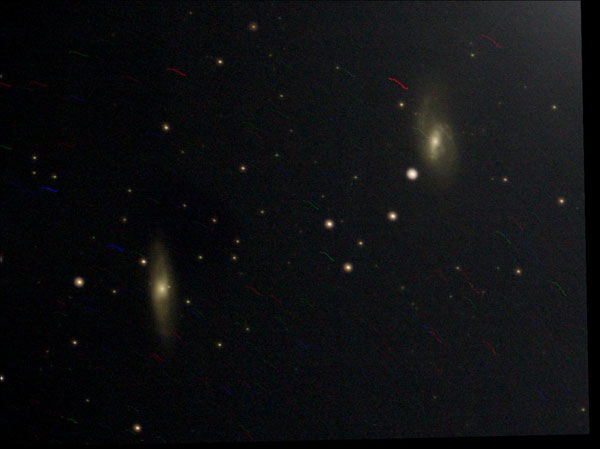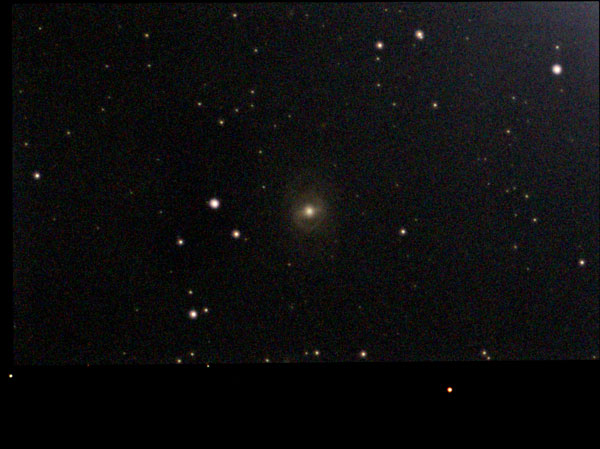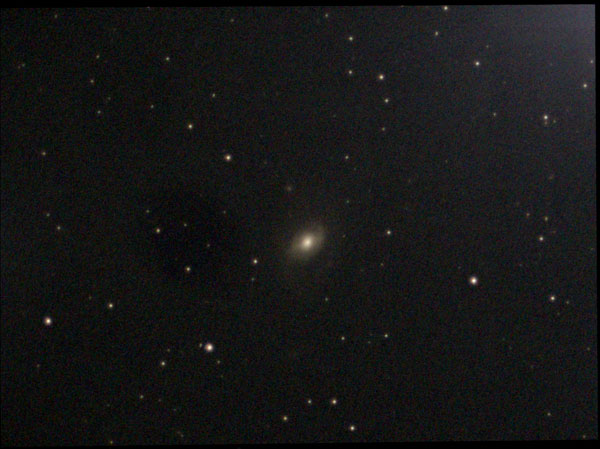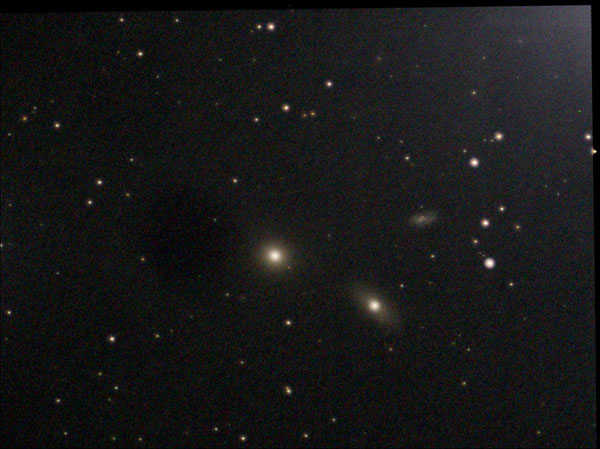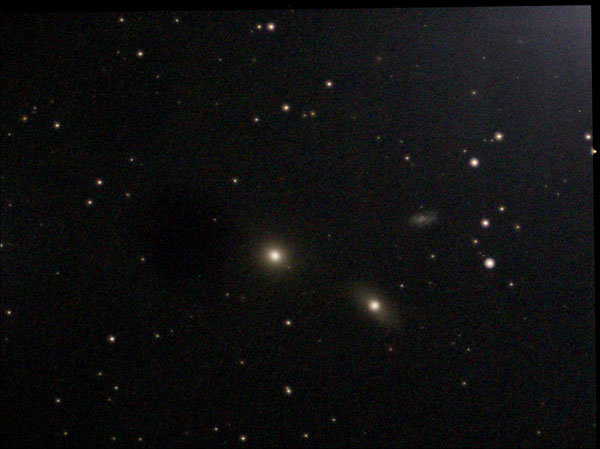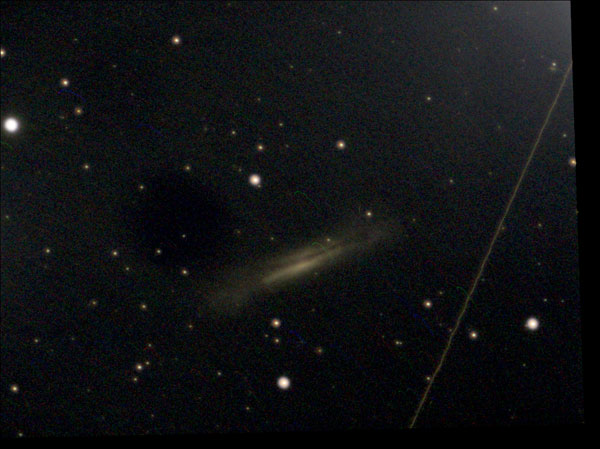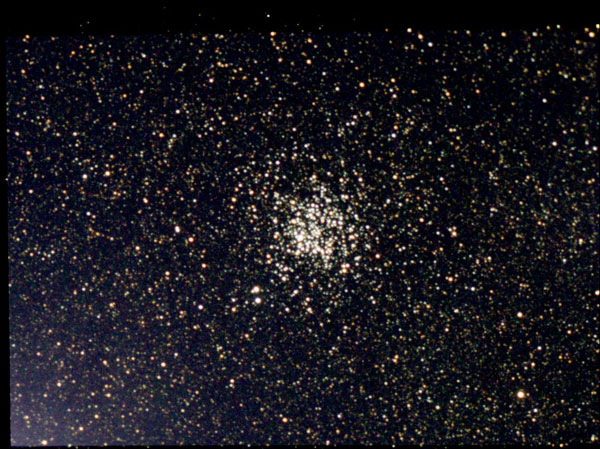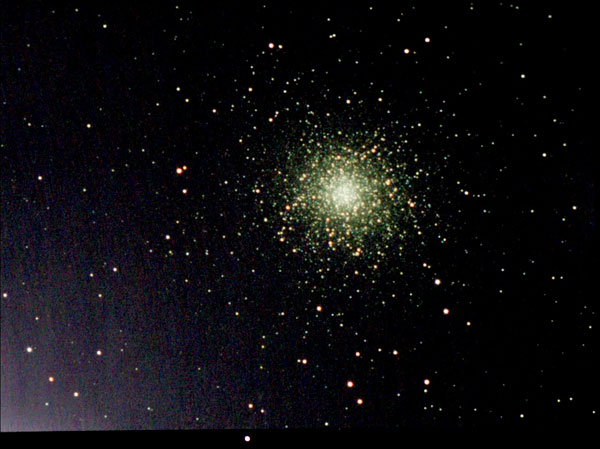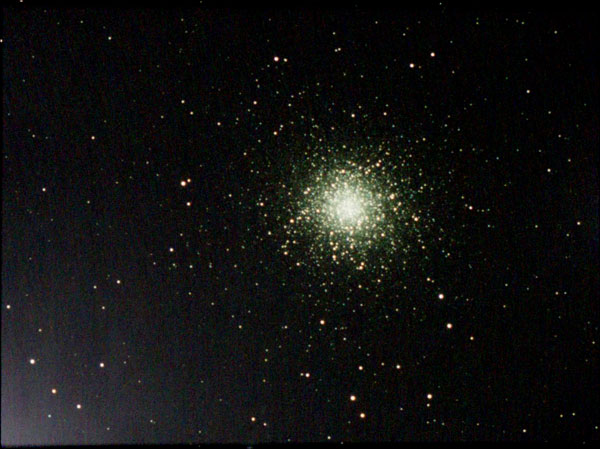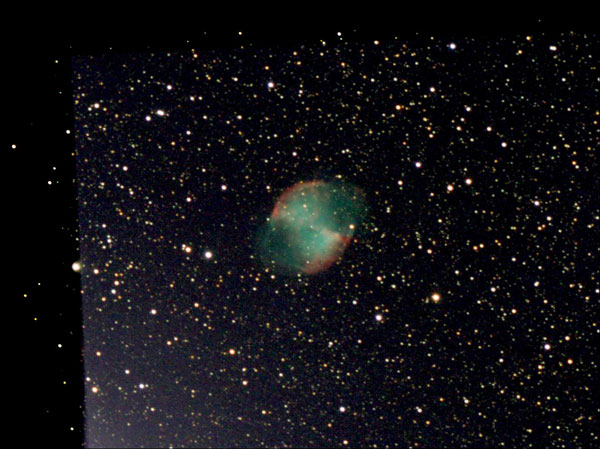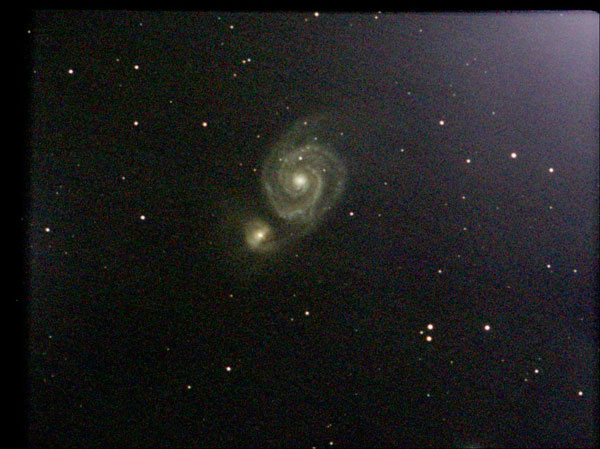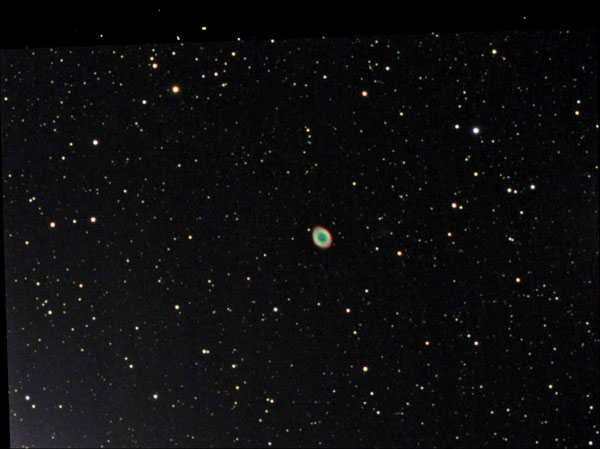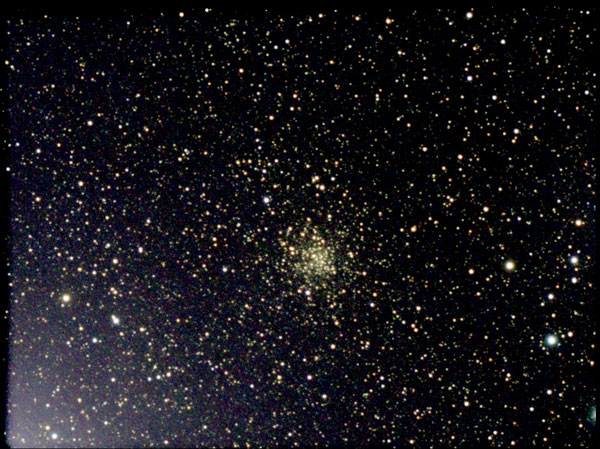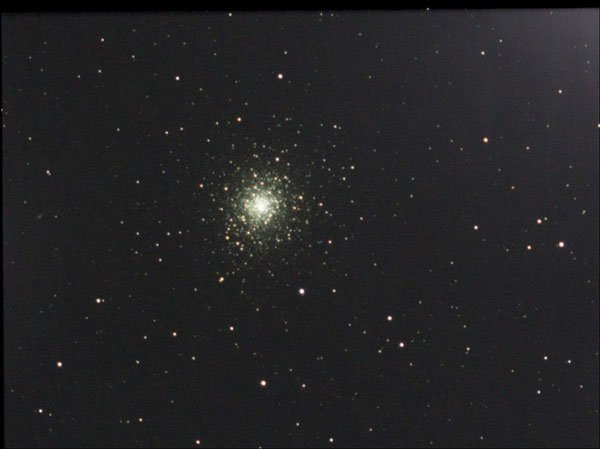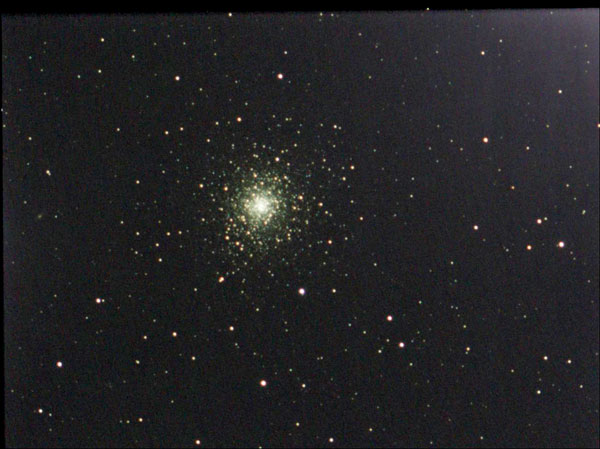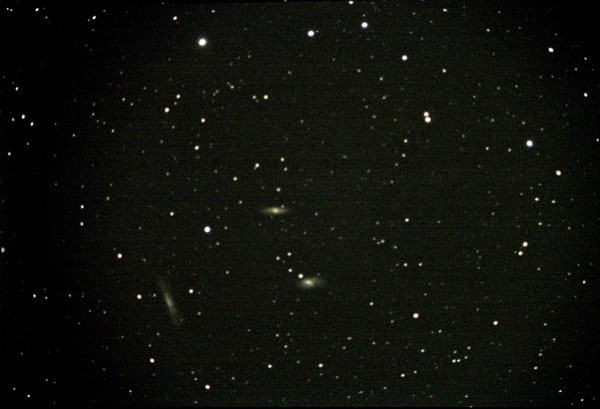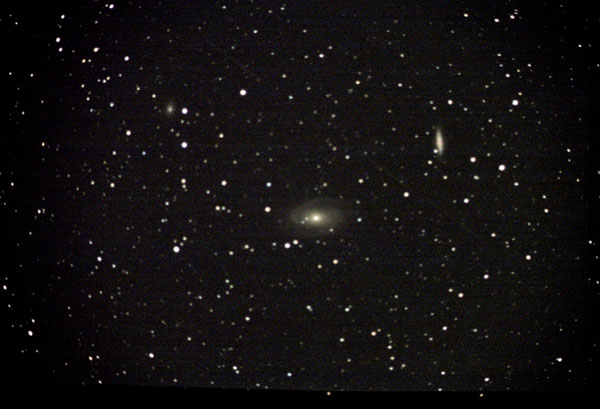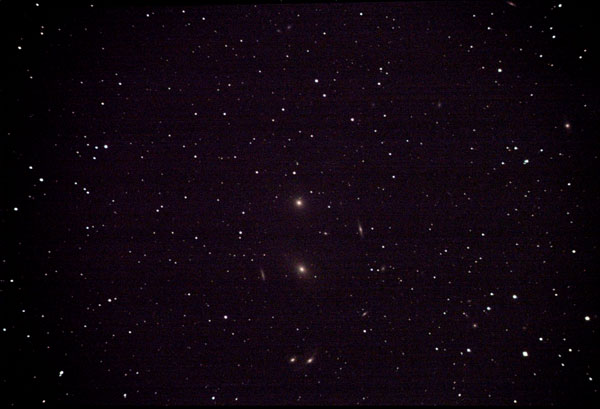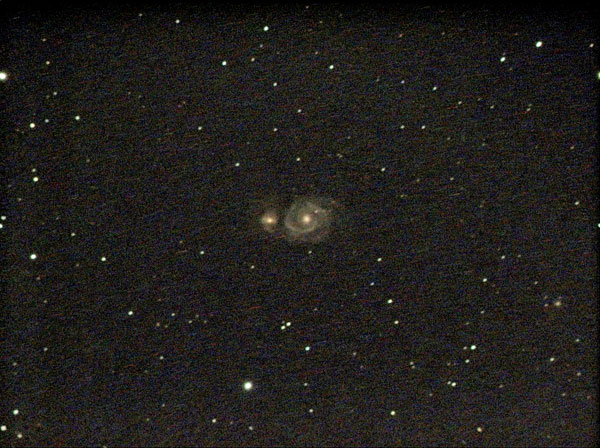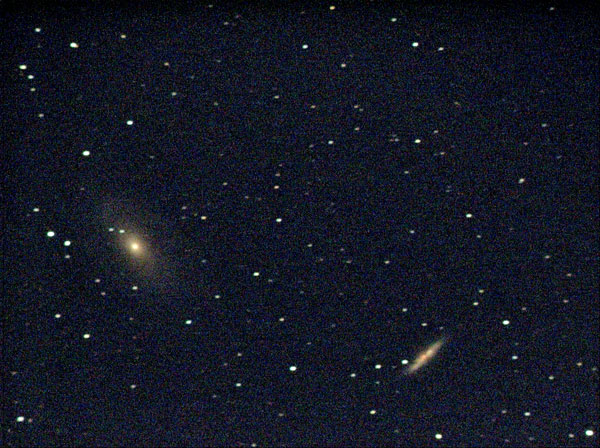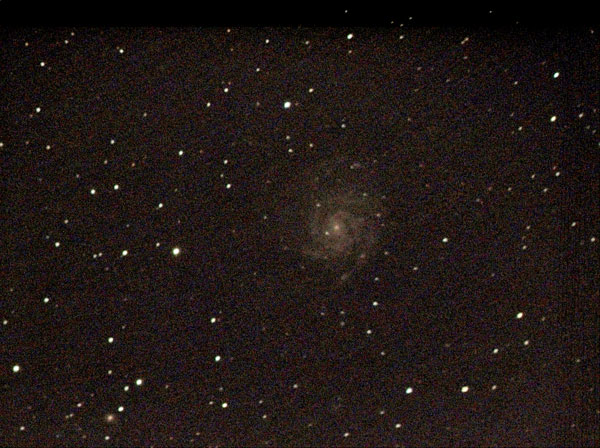Omegon Refractor 72/432
Motivation | Look | Visited Sky Objects | First Experiences | More Experiences | Issues | Photo Attempts | First Conclusions | Competition... | Links | Appendix: Data
On this page I provide some information about my 2.8" Omegon apochromatic refractor Pro APO AP Photography Scope 72/432 ED OTA (purchased on September 8,2018 at the AME2018 astronomy fair, received on September 11, 2018). For simplicity, I will mostly call it (Omegon) PS 72/432 or just PS72. I use this telescope for quick-and-dirty observations, on vacations (I have already taken it with me on two vacations), and also for EAA (electronically assisted astronomy).
See the appendix for the data.
Note: Thomas Gade found identical versions of Omegon, SNYPEX (as Knight PT 72 mm or Snypex Digiscope) and Teleskop Service as TSED346R.
Motivation (after Buying It, before I Received It)
Refractors are praised again and again for their sharp and constrasty image, but also criticized because of their color aberrations. Only refractors with very expensive glass seem to be free of color aberrations. And not always seems too be "ED" inside where there is "ED" written on the tube... Although I have no experiences with refractors so far, the praises that I have read have enticed me again and again to purchase one. Every time I found a cheaper refractor on the Internet, I called my astronomy dealer and asked him for his opinion on the respective device. And he advised against it again and again because of the strong color aberrations, so that I have never purchased a refractor.
But now I bought one, and this is how that happened: At the beginning of September 2018, I visited the AME2018 astronomy fair in Villingen-Schwenningen and came across a lot of small refractors, whereby my wife and I especially liked the Omegon refractor PS 72/432 ED. Again, it had an "ED" on it and in its name, but with a regular price of almost 500 EUR (formerly 600 EUR) it was probably not really to be expected that the optics is free of color aberrations... After some back and forth, I tried to get some advice, which was not easy indeed. The salesman that I finally spoke to did not really know anything about this special device, which I noticed soon, but also later, when I read tests of the device. After further back and forth, I finally decided to order the refractor, also enticed by the fair rebate, because we liked so much how it looked - also because of its special focusing mechanism, which later turned out to be a "helical focuser" (internal focusing).
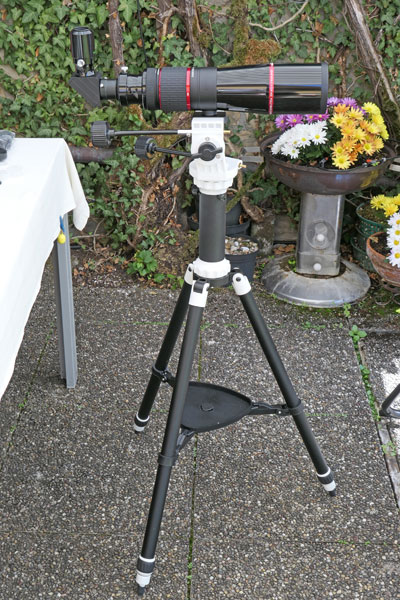 |
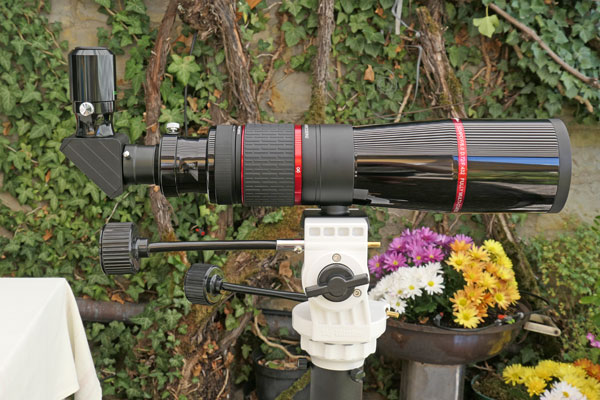 |
||
Side view of PS72/432 on AZ Pronto mount with extension tube |
Ditto (detail) |
Other side, on AZ Pronto mount with extension tube |
Ditto (detail) |
Back at home, I found a test report by Thomas Gade as well as one in Abenteuer Astronomie (extra issue 1/2017), which I probably read before. It turned out that I had decided on a very special device that offers three areas of application: camera lens, spotting scope, and telescope. Kowa offers a somewhat similar device (telephoto lens Kowa TP 556) for the price of 2500 EUR, and this certainly plays in another category (it has a bit more of everything...). But the external similarities, including the red rings and the focusing mechanism, are unmistakable. Surely a "real" refractor (e.g. Sky-Watcher Evostar 72ED or the TS Optics (TS Optics Apochromatic Refractor AP 72/432 FPL53 Photoline OTA) would have been a better choice...
In the Abenteuer Astronomie test, the first problem that I will have to face came to light: the device has no viewfinder and a adding one is not possible at all! Gade overlooks this discretely... Maybe something can still be done??? When I called the dealer and asked for a solution they recommended glueing on the Rigel Quick Finder.
The second problem, which probably will not hit me that hard, is that the Vixen rail is a little short and not movable (the latter can be a problem when using heavy cameras).
Gade furthermore complains about the sensitive varnish and the rubber armoring of the larger focus ring, but otherwise both testers evaluate the optics as better than I had feared... This made me curious to see how this refractor would prove itself as a travel telescope and a telescope for "fast-use," especially in comparison with my Heritage 100P.
Look
Unpacking
|
Outer package |
Ditto |
Ditto |
|
Ditto, opened |
Opened package |
Suitcase in protective foam |
|
Suitcase |
Ditto, opened |
Ditto, telescope visible |
|
Ditto |
Ditto, telescope removed, plastic cover stored in suitcase |
Telescope on top of the suitcase |
Accessories: None, just a brief manual |
Box size: 56 cm x 20 cm x 23.5 cm (my own measurement) Suitcase size: 54 cm x 19 cm x 17 cm (my own measurement, box without protruding elements)
|
Refractor on AZ Pronto Mount
PS 72/432-Refractor on AZ-GTi Mount (AZ-GTi Mount Head and AZ Pronto Tripod)
Visited Sky Objects
So far, I have visited the following sky objects with the Omegon PS 72/432:
- Moon (different phases)
- Mars, Saturn, Jupiter
- IC 4665
- M 2, M 3, M 5, M 8/NGC 6530, M 11, M 13, M 15, M 16, M 17, M 18, M 22, M 27, M 28, M 31, M 33, M 34, M 35, M 36-38, M 39, M 41, M 42/43, M 44, M 45, M 46, M 47, M 48, M 50, M 51, M 52, M 56, M 57, M 71, M 81/82, M 92, M 103
- Cr 399
- Mel 20, Mel 25, Mel 111
- NGC 457, NGC 663, NGC 752, NGC 884/869
- St 2
- Double Double separated; Albireo; Alcor and Mizar
- Atik Infinity: M 35, M 42/43, M 45, M 78, NGC 1977, NGC 2024 (with and without Horse Head Nebula B 33)
- ZWO ASI224: M 42/43, M 51, M 57, M 65/66, M 78, M 92, M 95, M 96, M 105, NGC 2024
First Experiences
As a Spotting Scope...
Since I never owned a refractor before, I was curious about my very first experiences with the Omegon PS 72/432. I made these in daylight at first, more or less directly after unpacking. For this first encounter, I took a 2" to 1.25" adapter from my Explorer 150PDS and inserted it into the telescope, because I own only 1.25" equipment (except for one 2" eyepiece). Then I looked through the telescope using either my Baader Amici prism or my Lacerta zenith mirror, trying out a number of eyepieces, at our sunflowers and trees in the neighboring garden. Initially, I used my 24 mm eyepiece (18 x), later I tried other focal lengths down to 4 mm (108 x), and at the end I tried my 32 mm eyepiece (13.5 x). The latter resulted in just a little bit more magnification than my binoculars deliver... When using an eyepiece of 4 mm focal length (this worked only with the zenith prism) the image was quite dark...
During my experiments, especially with the Amici prism, I did not always come into focus, which obviously depended on the eyepiece used. My 10 mm University Optics eyepiece seemed to be most critical in this respect seemed. Perhaps this problem was related to the conversion from 2" to 1.25", further tests should reveal this...
By the way, I tried out another cheaper Amici prism, which wanted to give away as a gift, and was not able to see any notable differences in the optical performance, except that the eyepieces came even less into focus with it...
Finder Experiments...
As I knew soon after the purchase and before I got the telescope, the Omegon PS72 has no viewfinder shoe. As I found out quickly, it is not alone in this respect, but on other similar telescopes a viewfinder is easier to attach because they feature a normal focuser.
I took the redo dot finder from my Heritage 100P for a start and tried a typical "Gerd Waloszek solution" using rubber bands. If you use enough rubber bands, the finder sits reasonably tight on the tube...
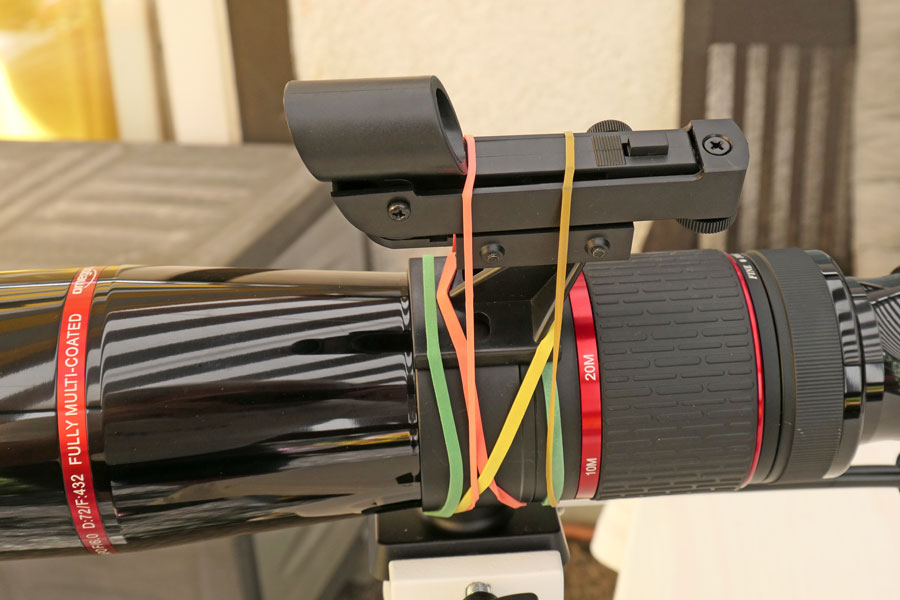 |
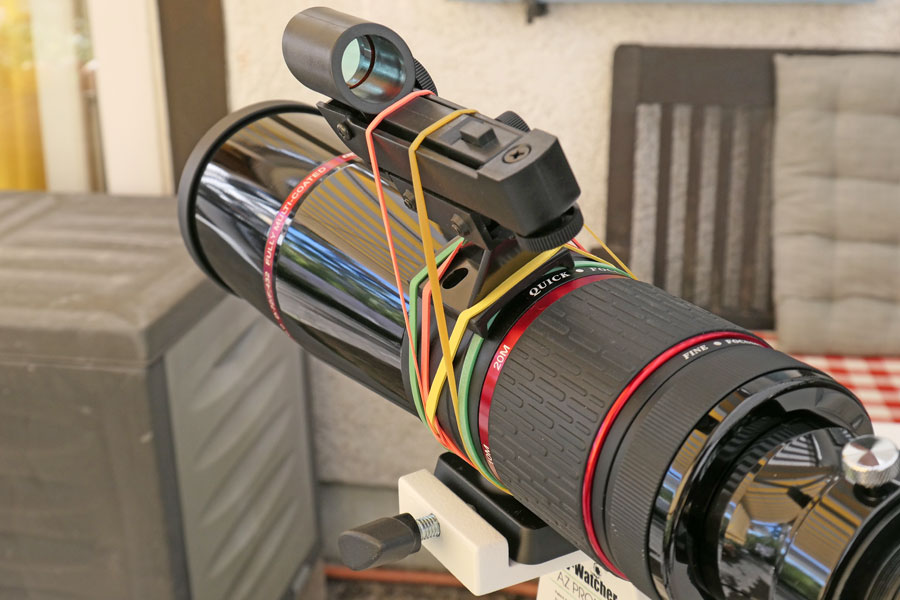 |
This was, however, not supposed to become a "permanent solution" - and it did not...
As a Telescope (First Night)...
After I had found differences when focusing in daylight with different eyepieces and the Amici prism (I had also tested a second one and found further differences in focusing), I was completely surprised and shocked when I wanted to focus on the very narrow crescent of the moon using the Lacerta zenith mirror. Except for one eyepiece, my 24 mm Televue eyepiece, none of my eyepieces came into focus. The 10 mm eyepiece from University Optics, which I had already noticed as critical on the Amici prism, was the most extreme one in this respect. And the 24 mm eyepiece was practically "at the limit," and I was never quite sure whether the image was indeed in focus. So again and again, I turned the fine adjustment a little bit, until it was also "at the limit," without coming to any definite conclusions. In retrospect, I would say that it was not exactly focused...
And what I saw from Arcturus or Mars was by no means a dot or a disk shape as I had hoped for, and perhaps expected. Whether this is "normal" for such a telescope, or whether mine is a "lemon," I would probably only find out in the course of time (also in comparison with the similarly magnifying Heritage 100P, see below).
At least, I was able to observe a few targets in the night sky, such as M 13, M 92, M 56 (quite faint), M 31, and the coat hanger Cr 399. I found especially the more diffuse objects quite beautiful (but also small...). Although the "rubber band viewfinder" worked quite well, I had problems with finding some observation targets. In the end, the TS binoculars helped me to locate the targets and to find them with the telescope as well.
Since I wanted to go on vacation a few days later, it was now too late for further experiments with newly purchased accessories, such as a 2" zenith mirror. And thus, using the telescope on vacation, as I had intended, did not seem possible.
At night, I remembered that I owned another zenith mirror, which the former owner of my Skymax-127 had installed in a self-built angle finder. He had replaced the Sky-Watcher zenith mirror with a dielectric one from Lacerta - and I had made my observations with this one. However, the angle finder was difficult to disassemble, so that I had to wait for the next morning, until I was able to "restore" the zenith mirror.
I then performed a test on terrestrial targets as far away as possible (crane, antenna) using all my eyepieces. And I was pleasantly surprised: Except for the already mentioned 10 mm eyepiece, I came into focus with all of my eyepieces, however, with different focus points on the coarse focusing scale. And that gave me hope that I might also get into focus with the moon, planets, and stars with these eyepieces. And with this pleasing result, using the telescope on vacation seemed, much to my joy, to be in reach again!
Photos: Omegon PS72 with simple Sky-Watcher zenith mirror
Second Night with the PS72...
The following evening was meant to reveal whether the Omegon refractor PS 72/432 is also usable for sky observations in conjunction with the Sky-Watcher zenith mirror, if so, with which of my eyepieces, and how it compares with the Sky-Watcher Heritage 100P, which plays in a similar league. The Heritage 100P has a larger aperture, but I have read again and again that a 70 mm refractor corresponds to about a 100 mm Newtonian telescope because it has no obstruction (the numerical values found for Newton telescopes, typically do not include the obstruction; the data is based solely on the aperture).
First I tested my eyepieces on the PS72, and all but the 10 mm eyepiece came into focus on celestial objects as well. Then I tested the refractor at the crescent moon (3rd day after New Moon), where the sky was still quite bright at the beginning, and compared it with the Heritage 100P at similar magnifications. It quickly turned out that the 2 x focus extender from Explore Scientific, which I needed to arrive at similar focal lengths, only came into focus on the Heritage 100P. I tested 7 mm against 16 mm with extender, and 4 mm against 7 mm with extender, whereby I always used the extender version on the Heritage 100P. At the beginning, I also tested longer focal lengths like 24 mm and 16 mm alternately in both telescopes. Since the crescent of the moon was now a bit wider than the day before, I was able to see craters and parts of the Mare Crisium well and to judge the view in both telescopes. At low magnifications, the view in the refractor showed clearly more contrast and was sharper than that in the 100P, at 100x magnification the view seemed to be slightly brighter in the Heritage 100P, but probably less sharp than in the PS72. The latter might also be due to my difficulties with adjusting the focus on the 100P.
I also tested the telescopes on Mars and Saturn with up to 100 x magnification. Saturn appeared slightly sharper in the refractor, with Mars it was sometimes the same and sometimes the other way round, not allowing a clear statement. The results for the PS72 were in any case much better than my first attempts on Mars the day before.
Since I now came into the focus with the refractor "from both sides," I was also able to achieve a much better image quality on stars than on the first day. Fortunately, my fears of having received a "lemon" were not confirmed. I saw this very nicely on the coat hanger Cr 399, which can still be seen completely in both telescopes: It looked nice in both telescopes (fine star points) - perhaps the PS72 had a slight edge here... The double star Double Double in Lyra was another "hard test" for both telescopes: From a magnification of about 100 x on, you should be able to see 4 stars, that is, two star pairs. My Maksutov telescopes had passed this test well in August 2018 (even below a magnification of 100 x ), but with the Heritage 100P I had tried in vain to further resolve the two main stars in autumn 2017. This was the same again even with a magnification of 114 x! The PS72 refractor, on the other hand, was able to resolve one double star at a magnification of 108 x, and for the other one I was able to at least guess that it was a double star.
I also observed a number of deep sky objects with both telescopes at different magnifications; this was less about sharpness than about brightness: M 13 (Hercules Cluster), M 31 (Andromeda Galaxy) and M 57 (Ring Nebula in Lyra). All of them were well to see in both telescopes, but the Ring Nebula was not a ring. My impression was that the objects in the Heritage 100P were perhaps a little bit brighter and perhaps a bit more extended. This would not surprise me at all, considering the larger aperture and exit pupil of the Heritage 100P (but note the obstruction...). Overall, however, both telescopes delivered quite similar results.
Conclusion: The Omegon refractor PS 72/432 can be used with the Sky-Watcher zenith mirror with most of my eyepieces for night observations, delivers a somewhat better performance than the Heritage 100P at the moon and at double stars, and is perhaps slightly inferior to it at DSOs. In any case, the next day I packed the refractor for our vacation, even if the waxing moon did not promise great observational nights...
Third Night with the PS72...
Before our vacation, I wanted to see, whether I can also find the Dumbbell Nebula M 27 with the PS72, because I had found out that it is not far away from the already visited coat hanger Cr 399. In addition, the double star Albireo is nearby, also a worthwhile target! After installing the telescopes PS72 and Heritage 100P, however, the nearly half moon was my first target, because it was still relatively bright. The craters Theophilus, Cyrillus and Catharina near the terminator were nice to see. On the PS72, I increased the magnification up to 324x, at which the image looked a bit blurred, but was still acceptable (far beyond the beneficial magnification). And so it came: After using the 2 x focus extender on the Heritage 100P to achieve magnifications similar to those on the PS72 there in parallel, I this time also tried the 3 x focus extender, for whatever reason... To my surprise, it also worked on the PS72, and even with the 10 mm eyepiece. This surprise was of course a pleasant one, and so I used the 3x focus extender again and again on the PS72. My 4 mm eyepiece with a focal length of 432 mm and the 3x focus extender leads to a 324 x magnification. With the 7 mm eyepiece it is 185 x, with the 10 mm eyepiece it is 130 x and with the 16 mm eyepiece it is 81 x (the first three are beyond the beneficial magnification). Of course, this opens up completely new possibilities!
Before I ventured to the Dumbbell Nebula M 27, I first found the coat hanger Cr 399 by chance and later the double star Albireo, which could already be separated with a 24 mm eyepiece (18 x). With some effort and the help of SkySafari 6, I finally found the Dumbbell Nebula M 27, even with both telescopes, and observed it at different magnifications of up to 100 x. It was a more or less round diffuse and faint glow, but there was no doubt about the detection. Both telescopes showed a similar performance.
By the way, this time it turned out that the 2" to 1.25" adapter that I "borrowed" from the Explorer 150PDS attached to the telescope only very unreliably, so that the purchase of a 2" zenith mirror after our vacation seemed advisable. Consequently, after our vacation (at the beginning of October 2018), I bought an Omegon 2" zenith mirror and the Amici prism offered by Omegon, which adapts from 2" to 1.25". And maybe there will be more 2" eyepieces in addition to my 28 mm eyepiece from Sky-Watcher that comes with the Explorer 150 PDS. Unfortunately, 2" eyepieces are very expensive, but perhaps I will find some in the used market...
Photos: Omegon star diagonal with 99% reflection, 2" and Omegon 45°, 2'' to 1.25'' Amici prism
More Experiences
The PS72 on Vacation in France 2018
As announced above, I took the PS72 with me on our 2018 autumn vacation to France. I observed the moon, the planets Jupiter, Saturn, and Mars, as well as a number of deep sky objects. I describe these observations on page Deep Sky Summer/Autumn Observations September-November 2018. All in all, I was quite satisfied with the performance of the telescope, but there were also some objects that I was not able to find at all...
2" Amici Prism
After our vacation in France I ordered the matching Amici prism from Astroshop.de, which adapts from 2" to 1.25". Unfortunately, my copy has a gray and not a red ring, although it is especially recommended for this telescope...
Omegon Amici Prism 45° 2'' to 1.25" |
Ditto mounted to the telescope |
Ditto,closer view |
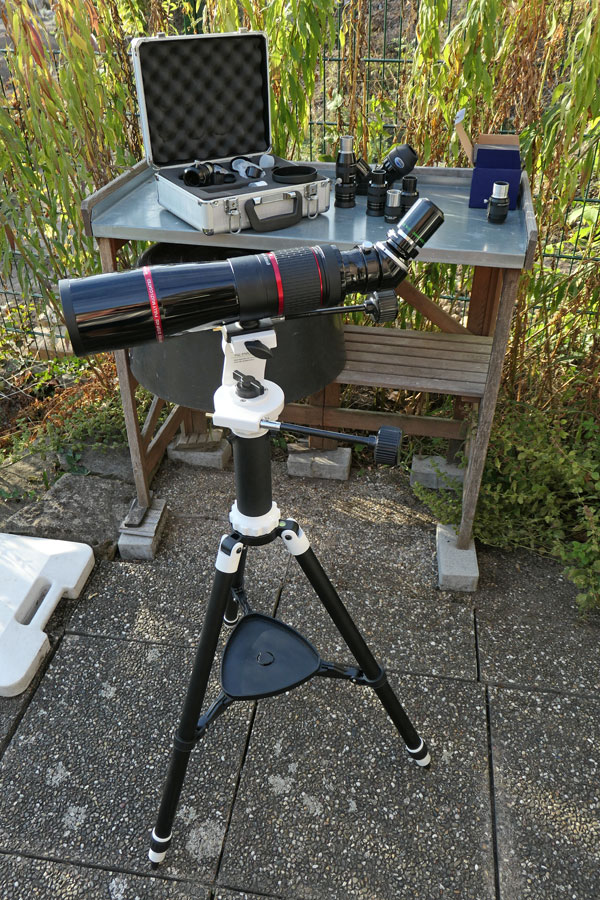 |
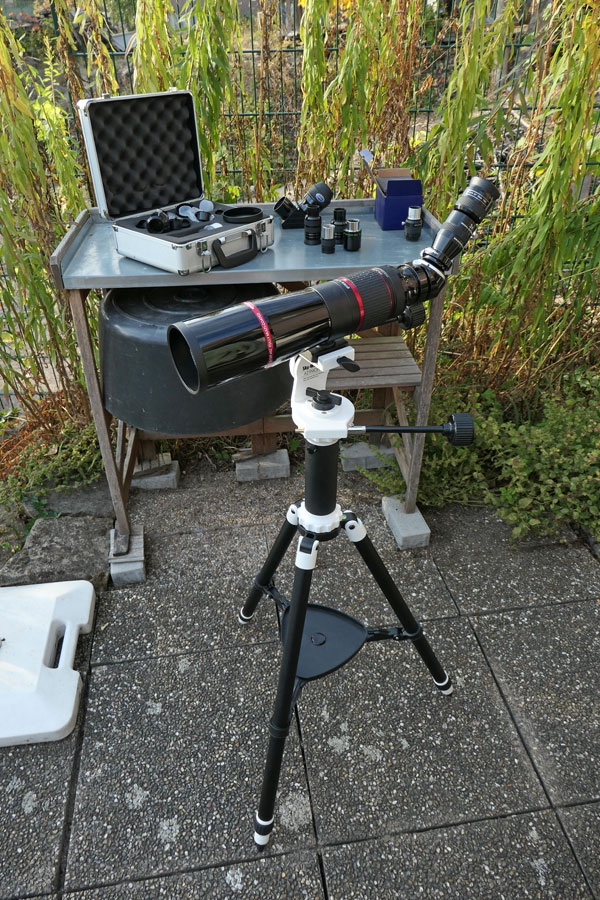 |
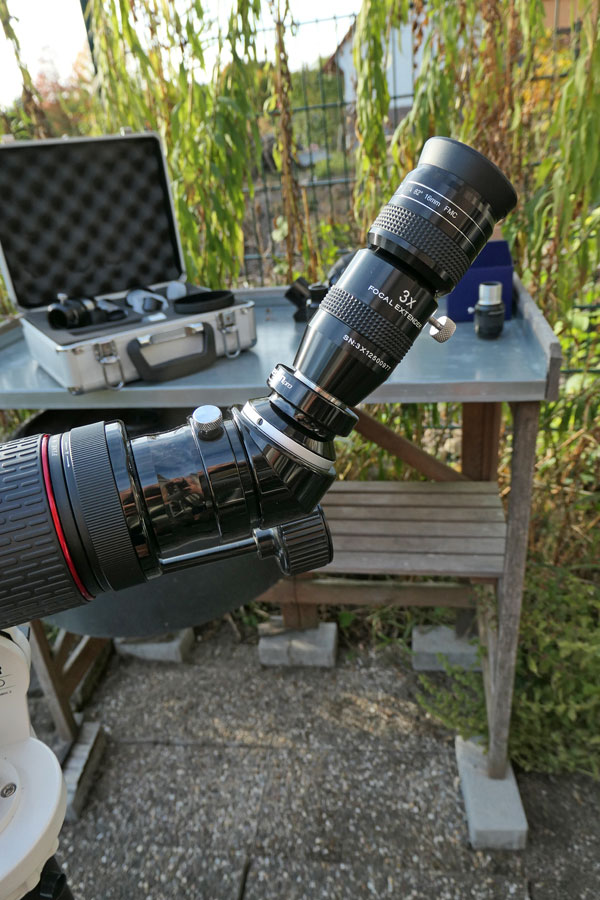 |
| Ditto, with equipment | Ditto, with 3 x focal extender | Ditto, closer view |
Photos: Omegon Amici Prism 45° 2'' to 1.25"
On the day of its arrival, I briefly tried out the Amici prism (as long as it was bright enough...), and everything made a very good impression on me - as long as I stayed below a magnification of 100 x. Beyond this value, the view became quite dark...
The next day, I tried all my eyepieces, as well as my focal length extenders with some eyepieces. At a distant target (about 100 m), all eyepieces/combinations came into focus. At a near target about 8 m away, I had to pull out some eyepieces a little to get into focus. All in all, this is a very satisfying result!
2" Zenith Mirror
After my vacation in France, I also ordered a dielectric 2" zenith mirror from Astroshop.de, which comes with a 2"-to-1,25"-adapter. Compared with a 1.25" zenith prism, this is quite huge! The adapter is constructed differently than the one from Sky-Watcher that I had used so far, and it also holds securely in the eyepiece extension, so that I might also use a 1.25" zenith mirror with it. But this does not really make sense if you own a 2" zenith mirror...
Omegon zenith mirror 90°,
2", dielectric coating with 2" to 1.25" adapter |
Omegon 2" zenith mirror at the
telescope |
Ditto, with 1.25" eyepiece
and adapter |
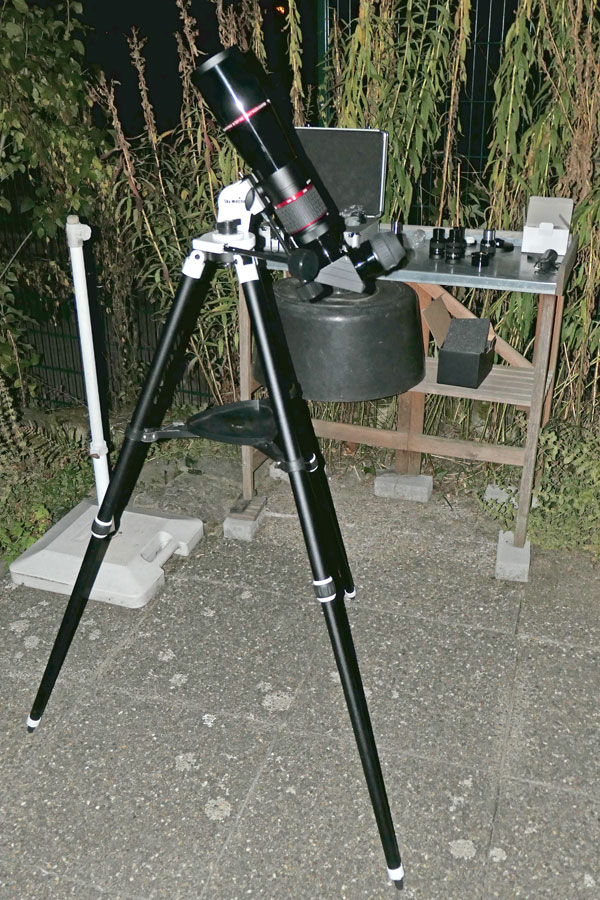 |
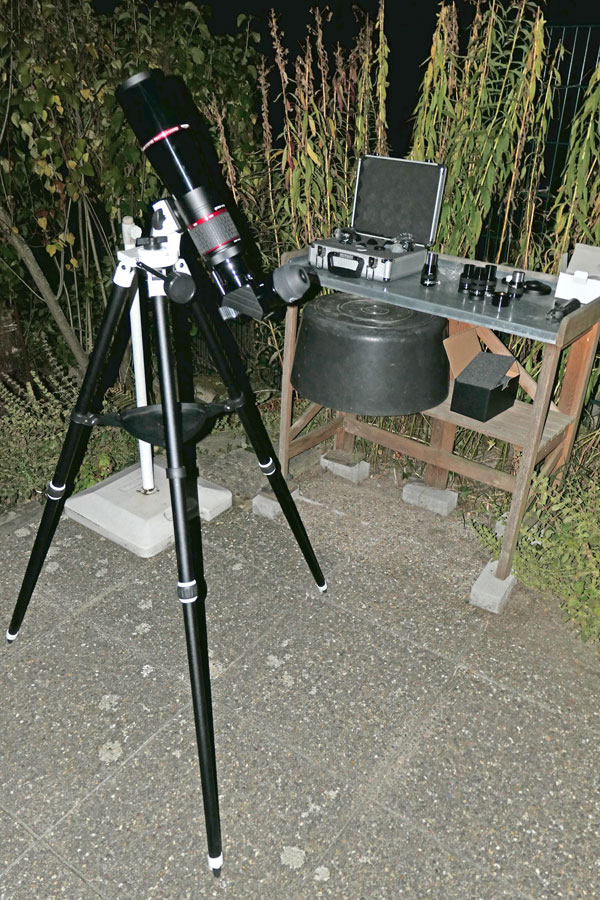 |
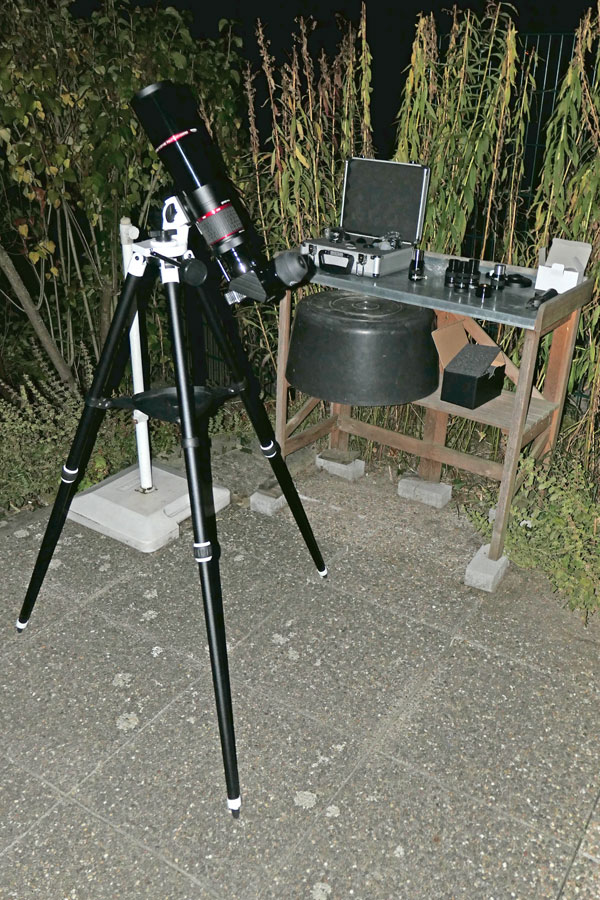 |
| Ditto, at night with equipment | Ditto | Ditto |
Photos: Omegon zenith mirror 90°, 2", dielectric coating with 2" to 1.25" adapter
I also tested my eyepieces and focal length extenders with the 2" zenith mirror. With the exception of the 10 mm eyepiece from University Optics (no longer in my possession), every eyepiece came into focus. With the latter, this was only possible with the 3 x focal length extender. As it turned out, the extension for the 10 mm eyepiece is too long - and not, as usually, too short. This eyepiece is generally somewhat special when it comes to focusing. Overall, I was also satisfied with this results and will now only use the 2" zenith mirror on this telescope.
For overviews, I can now use the 28 mm eyepiece (probably an Erfle eyepiece) from my Sky-Watcher Explorer 150PDS. It provides about the same field of view as my 32 mm Plössl eyepiece, but at a slightly higher magnification (during the day, it also shows a lower depth of field than the Plössl eyepiece).
Update: I bought a 35 mm TS UFL eyepiece (ED, 2"), which now serves for rich-field observations (5.59 degrees true viewing angle), later even a 40 mm Lacerta eyepiece of a similar type (ED). I do no longer own the 28 mm eyepiece, because I sold it together the the Explorer 150PDS to which it belonged. I replaced it with a 26 mm eyepiece (ED).
Rigel Finder
Above, I mentioned already my "viewfinder problem." My "rubber band solution" for the red dot finder has only proven itself to a limited extent, because the finder shifted its position too easily. I then purchased a Baader viewfinder shoe, but was not able to attach it somehow to the telescope without having to drill holes into the telescope tube... Earlier, an employee of my Astroshop dealer had already recommended the Rigel finder (Quick Finder) to me on the phone as a solution for my "finder problem." The base of the Rigel finder can be glued to the telescope. So I bought one after my failure with the Baader viewfinder shoe, especially since nothing else seemed to fit on its tube so small in diameter. However, I had my doubts whether the foot would really fit the tube... These doubts proved to be justified, as it turned out after I had unpacked the Rigel finder. Actually, I wanted to mount the viewfinder in the middle of the tube, about where it is attached to a tripod or mount. There would have been some space. But the Rigel base plate was too long and did not fit the tube because of its curvature. So only one position, on which the base would plate fit, remained, namely at the front of the dew cap, far away for locating stars. But because I did not know of any alternative, I tried this first...
At first, I just attached the Rigel finder to the telescope tube with many thick rubber bands. This might have worked during an observation session, but sometimes it did not even that... And above all, the finder had to be adjusted at every new session. That was annoying in the long run! So I decided to fix the base plate with the help of the supplied double-sided adhesive tape, hoping that it would remain firmly on the tube when packing the telescope away into its suitcase or bag. This has worked so far, but how long it will last is, of course, open.
|
Base plate of the Rigel finder attached to the telescope |
Rigel finder attached to the base plate |
|
Rigel finder side view |
Rigel finder front view |
|
Rigel finder side view |
Ditto |
When I had fastened the base plate with rubber bands, I had attached it somewhat obliquely, in order to be able to aim past the eyepiece. But when I glued the base plate to the tube, I glued it right on top of the tube, because that was the easiest way to do it and also because aligning the plate straight was easy this way. When I, however, had inserted the finder into the base plate and wanted to adjust it, I realized, which nonsense I had accomplished: The eyepiece stood exactly in the way, when I wanted to look along the telescope tube through the Rigel finder to the stars! Now I always have to loosen the zenith mirror to be able to tilt the eyepiece sideways, whenever I want to take a look through the viewfinder (or I have to take the eyepiece out of the zenith mirror). Well, I removed the base plate one day and glued it to another position... And later, I also glued a second finder show to the tube in order to accomodate different mounts (see update).
Furthermore, I found a disadvantage of the large distance from the viewfinder (which is at the front of the telescope and I am behind it): the two red rings appear very large on the mirror of the viewfinder. At least, both rings are still visible!
All in all, this was an installation with "mixed success."
Update
As already written, I glued on a second Rigel finder shoe in order to be able to use the Rigel finder with both horizontal (AZ Pronto) or vertical (AZ-GTi) mounting without having to contort myself. I attached both finder shoes with the double-sided tape that came with the Rigel finder. The rubber bands, on the other hand, are actually more for decoration than to stabilize anything...
Issues
There were - and still are - some issues with the PS72! That is, some issues were just initial problems, but others are "permanent" (or "intrinsic") ...
Focusing
The focusing proves to be quite stiff (in tests it is called "smooth"), so that now and then even the rubber ring of the quick (or coarse) focusing ring slipped through. Possibly it may also be the focusing mechanism itself, that "jumps". Fine focusing is even more stiff. Therefore, I often hold the mount during focusing so that the observed sky object remains in the field of view. I complained about this at the dealer and received a return note. I returned the telescope to have it repaired or replaced, but received it back as "being within the tolerances." In the meantime, I have changed my "focusing strategy" a bit and hope to be able to handle focusing better in the future... Basically, however, I consider the focusing, also because of its hysteresis, to be "borderline". A "normal" refractor with a 1:10 focuser would be much more useble!
Fitting 1.25" Accessories
As already reported, the Sky-Watcher 2" to 1.25" adapter from Sky-Watcher does not hold reliably in the 2" eyepiece connection. I also addressed this to the dealer and received an answer that did not quite fit, but pointed into the right direction. In the end, I solved this problem by buying a 2" zenith mirror and a new Amici prism with a 2" connection. The corresponding 2" to 1.25" adapter holds reliably in the eyepiece connection, so that I might use 1.25" zenith mirrors and Amici prisms as well...
Finder
My "rubber band solution" for the red dot finder had only proven itself to a limited extent, because the finder lost its laboriously installed position too easily. I then purchased a Baader viewfinder shoe, but was not able to attach it to the telescope without having to drill holes into the telescope tube... My Omegon dealer recommended the Rigel finder (Quick Finder) as a solution to my "finder problem," the base of which can be glued to the telescope, and I bought one after my failure with the Baader viewfinder shoe. My experiences with the Rigel finder can be found above. All in all, I think that this is an acceptable solution...
Color Fringes
And then I finally found color fringes, especially when observing the moon! Visually, they were yellow at the edge of the moon, photographically they were blue - and not only at the edge, but also visible at some craters. Probably one has to live with that when using an ED apochromate...
Online Technical Data
And last but not least, I encountered some problems that I found very confusing on the Web page for the telescope at Astroshop.de:
- The page stated that the telescope is not suitable for deep sky observations, whereas another telescope with the same data (72/432) is described as suitable. In two tests, however, the telescope is described as suitable for wide field DSO observations. I contacted the dealer about this, was asked to send an e-mail with a respective note and did so. I did not receive any "personal" feedback, but the telescope now has a "Yes" recommendation for DSO observations...
- In addition, the technical specifications include some values of a telescope with 66 mm aperture (exactly: 66.5 mm): these include the resolution, light collection power, and limiting visual stellar magnitude (for a comparable 72 mm telescope, the data is correct...). Since there is a similar telescope with 66 mm aperture, I suspect that the data was simply copied from there. I also tried to clarify this in another phone call and was promised that my suggestion would be forwarded. Regardless of whether the data will be corrected (this has not happened up to now, and probably never will), I will use the values calculated by me (or those of the other telescope with 72/432) from now on.
Photo Attempts
Used as a Spotting Scope
After my first "spotting scope" tests, I quickly tried to take a few photos of the sunflowers in our garden using the 32mm eyepiece with T-mount thread and my Sony RX100 M4 screwed to it (using a focal length of 70mm equiv.). Since it was windy and I did not use a remote release, I had little success.
Later, when there was less wind, I had another try (second row). This time, I used a cable release. The two best images that I got are shown here; they were postprocessed. All in all, it does not seem to be easy to get sharp photos with the telescope, particularly due to the narrow depth of field.
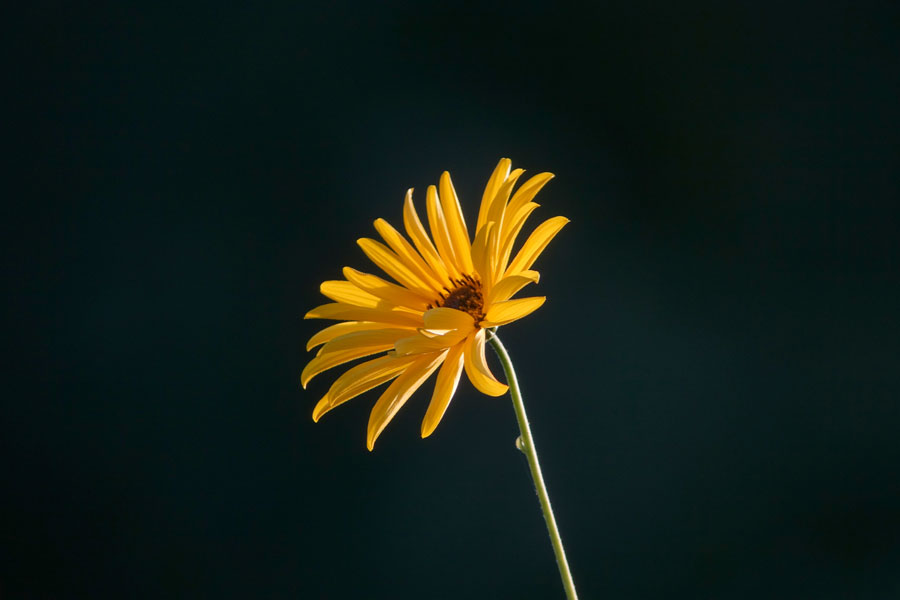 |
 |
Used as a Spotting Scope with 2" to 1.25" Amici Prism
In mid-October 2018, I made photo attempts with the new 2" to 1.25" Amici prism from Omegon. Here are some example photos! Overall, the picture quality seems to be better this time (the depth of field is very low, though...).
| 2500 pixels | 3200 pixels |
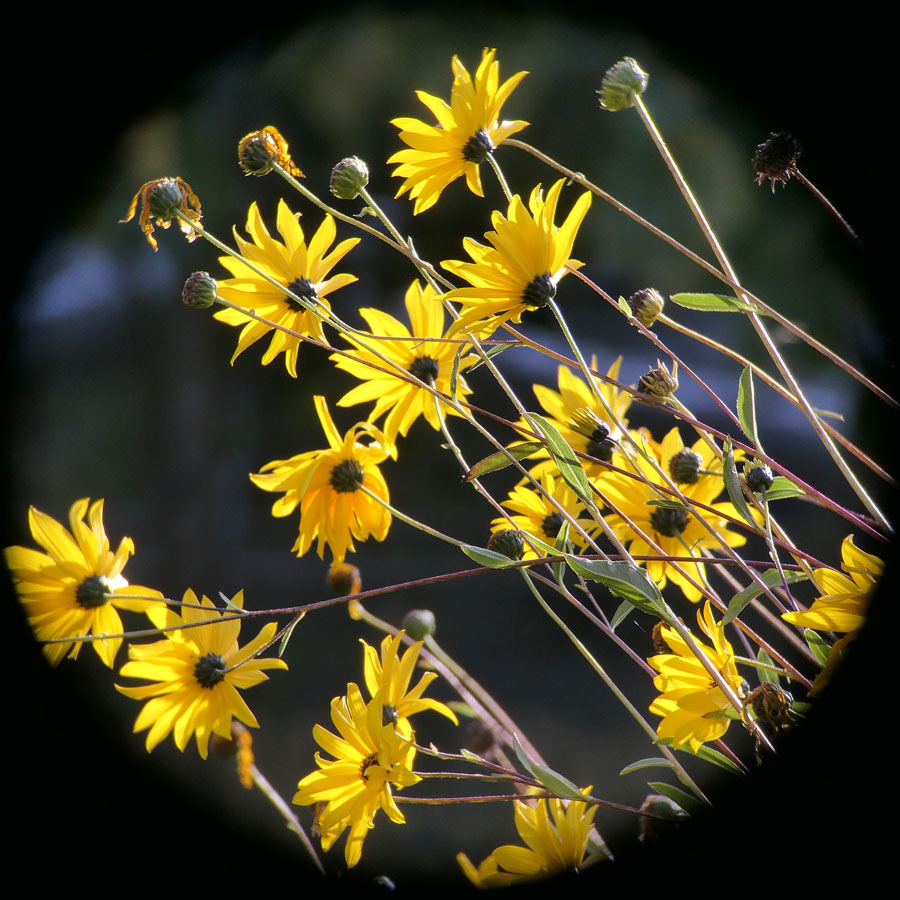 |
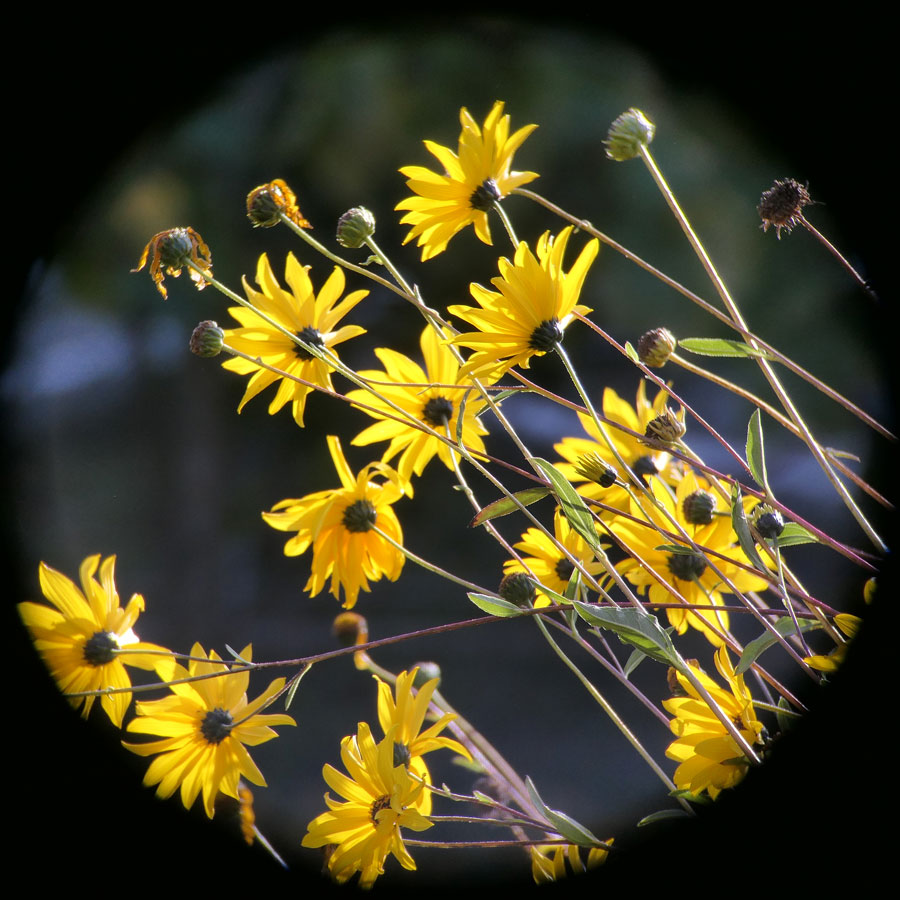 |
| 3200 pixels | 3200 pixels |
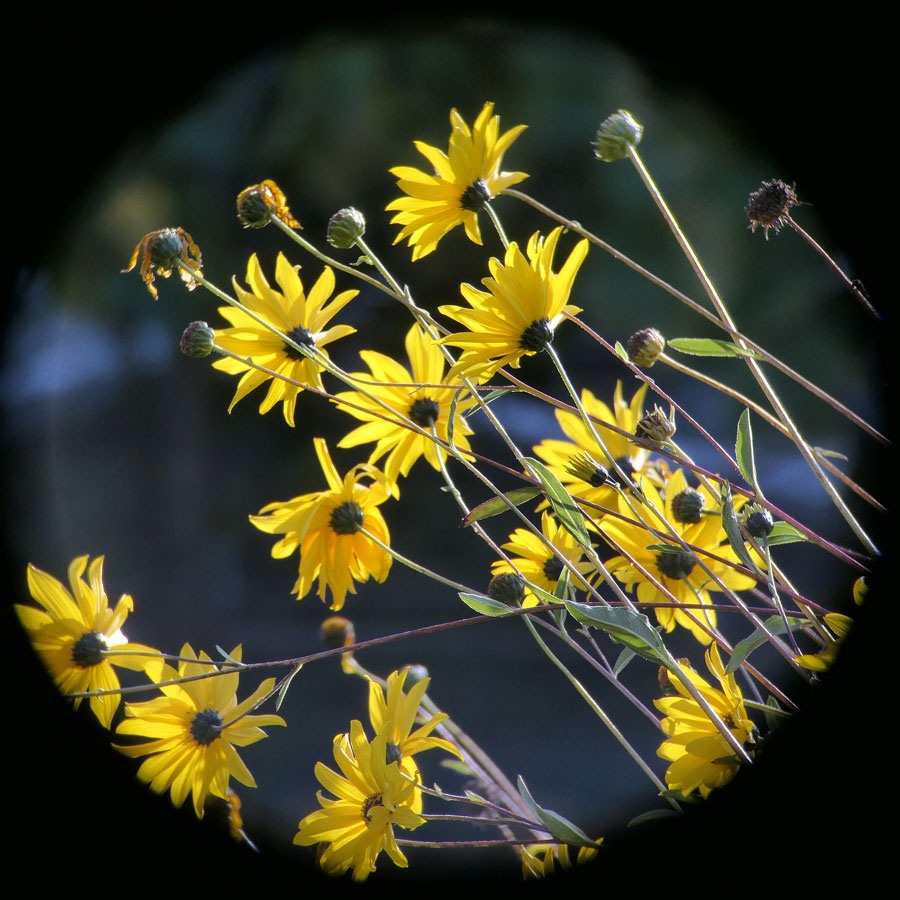 |
|
| 3200 pixels |
Afocal Photography: Moon
On September 19, 2018, I took photos of the moon in Sumène, France, using the 1:50 method, a 7 mm UWA eyepiece (magnification of about 60 x), and the Panasonic TZ202 camera. This was new in two respects: I used a new telescope and a new camera. I took two short series at ISO 400 and with manual focus, one with a focal length of 24 mm (equiv.), and another one with a focal length of 28 mm (equiv.). Here are two samples, one from each series:
| Taken with 24 mm focal length (2000 pixels version) | Taken with 28 mm focal length (2000 pixels version) |
Overall, there are blue color fringes, particularly at the edges of the moon. In addition, because of its noise behavior, the Panasonic TZ202 does not seem to be an ideal camera for astronomy photos. The second series taken with a focal length of 28 mm turned out to be more fuzzy for unknown reason. Using the presented sample from the 24 mm series, I looked for some small craters to estimate the resolution of the photo. With some good will, a crater of 5.1 km diameter is visible (Le Verrier B), but a more realistic estimate for the smallest visible craters seems to be a diameter of around 10 km. There are, however, craters of this size that are not visible on the photo, probably due to air turbulence.
| Five craters with diameters between 5.1 km and 25 km (2000 pixels version) | |
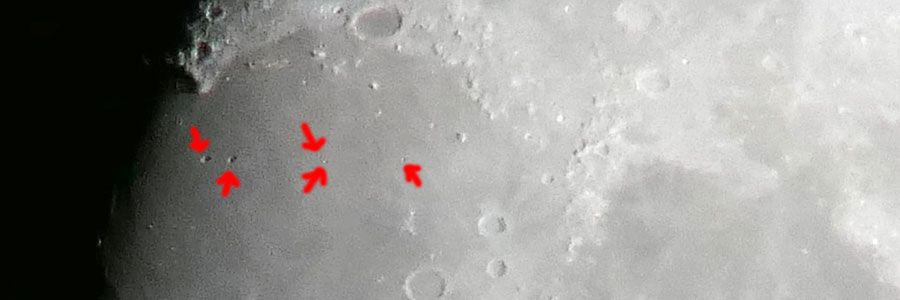 |
|
| The craters from left to right: Helicon (25 km), Le Verrier (20 km), Le Verrier B (5.1 km)???, Le Verrier D (9.1 km), Kirch (12 km) | |
Overall, this result is in line with what I have achieved with other telescopes and cameras.
Afocal Photography: Orion Nebula
The following attempt from April 6, 2020 to photograph the Orion Nebula with the PS72/432, the 32 mm DigiScope eyepiece, and a normal camera is rather to be understood as fun. But it shows that this is possible in principle.
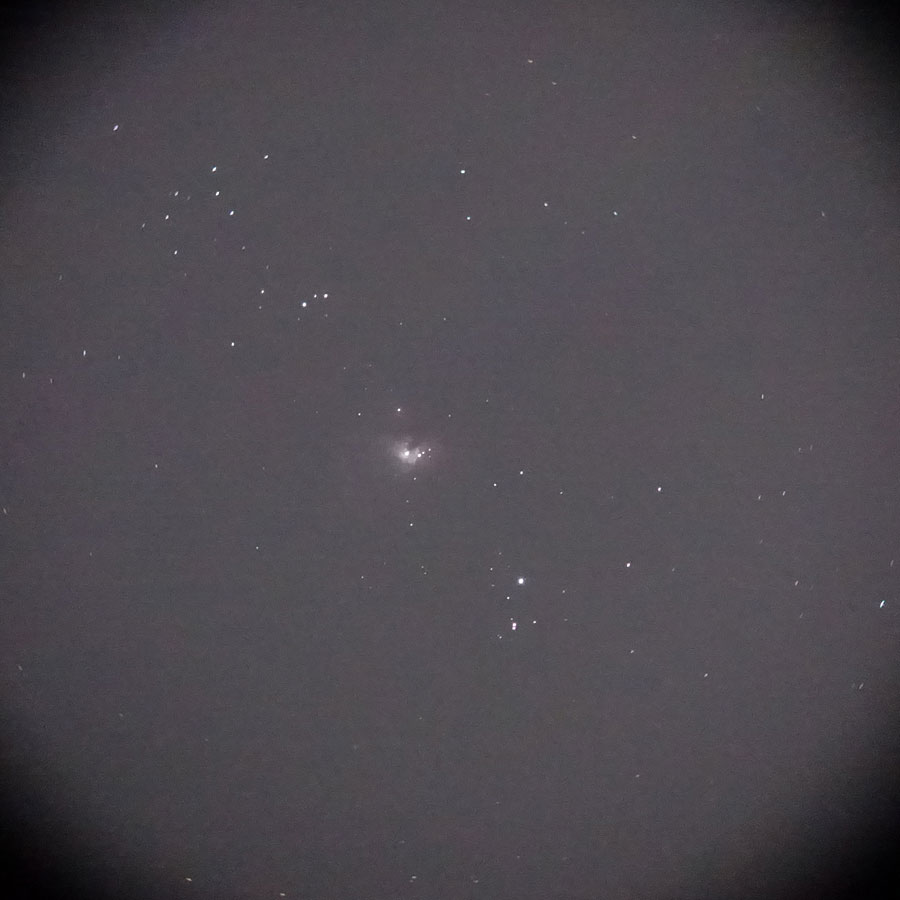 |
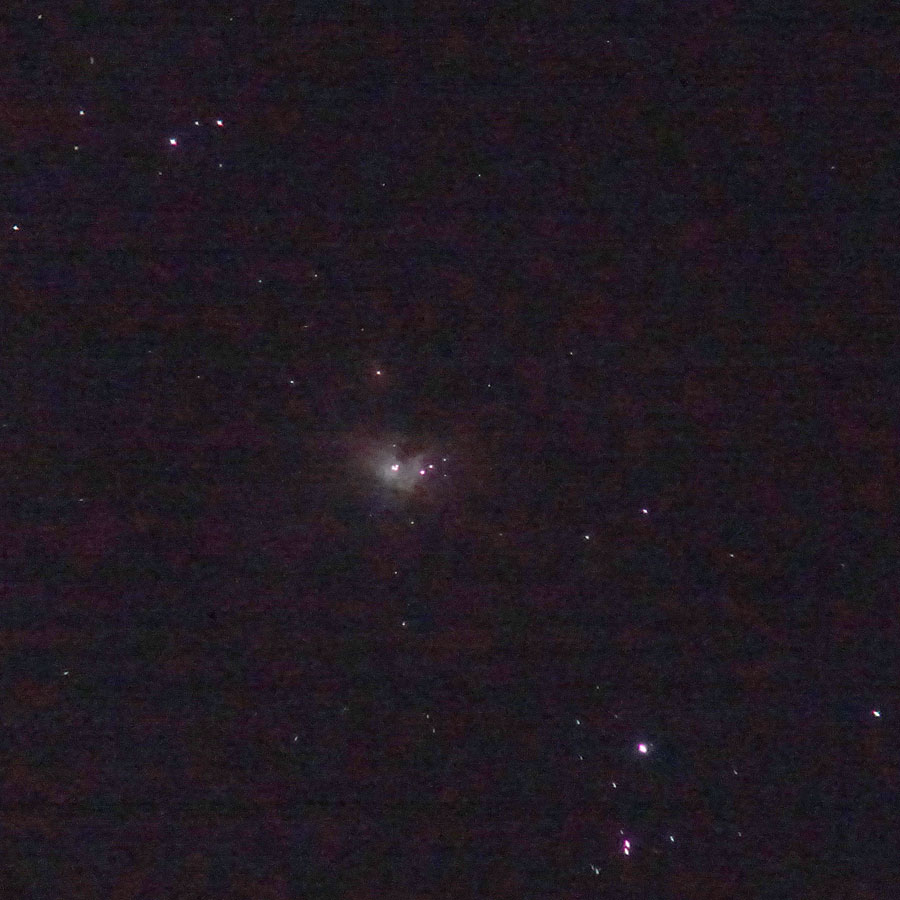 |
|
Orion Nebula with PS72 and RX100 M4 - 2400 pixels |
Orion Nebula with PS72 and RX100 M4 zoomed to 70 mm - 3000 pixels |
Dry Runs with Atik Infinity
In several dry runs (December 2020), I tested whether and how the Atik Infinity camera can be operated at the PS 72/432.
Note: 1.25" Omegon reducer = 2" to 1.25" adapter (not a focal length reducer!)
Results
- With 1.25" Omegon reducer, without everything: out of focus (light path too short)
- With T2 extension sleeves: sharp
- With 1.25" Omegon reducer, 1.25" Amici prism: sharp at infinity (just before infinity)
- With 1.25" Omegon reducer, 1.25" Lacerta zenith mirror: sharp at infinity (more "room" in front of infinity)
- With 1.25" Omegon reducer, 1.25 Celestron zenith mirror: sharp at infinity (just before 10 m, even more "room"; locking screws uncomfortable)
- With 2"-to-1.25" Omegon Amici prism: sharp between infinity and 20 m
- With 2" Omegon zenith mirror: out of focus (light path too long)
- With 2" TS-Optics zenith mirror: out of focus (light path too long, slightly less than with the Omegon zenith mirror)
Italic: Works; italic and bold: recommended
Selected Photos
|
PS 72/432 with 1.25" zenith mirror |
PS 72/432 with 2 "zenith mirror |
|
|
Result for photo above |
Result for photo above (out of focus) |
|
|
PS 72/432 with T2 extension sleeves, overview |
PS 72/432 with T2 extension sleeves |
Result |
|
PS 72/432 with T2 extension sleeves, overview |
Atik Infinity with T2 extension sleeves |
|
Night Test with Atik Infinity
On March 19, 2021, I made a first "night test" with the Atik Infinity camera at the Omegon PS 72/432 refractor. I used the following configuration: PS 72/432 refractor on the AZ-GTi mount, which I operated with the SynScan app on the iPhone. I performed a 1-star alignment. The camera was adapted to the telecsope using T2 extension sleeves.
I observed M 42/43 (Orion Nebula), NGC 2024 (Flame Nebula), and M 78. Here are some of the photos that I took during this session (and some comparison photos):
All in all, I found the results, except for those for M 42/43, fairly disappointing, in particular because they were rather faint. Moreover, I found focusing difficult with the PS 72/432 because of the hysteresis in its focusing mechanism. I did further night tests in the following days and in early April 2021 (then using a wedge) with similar results. Overall, I noticed that the stars appeared relatively "bloated" with this tube. These night tests, as well as the one presented, appear on page Atik Infinity - Further Experiences (Nightly Tests). More results will be presented elsewhere on this Website.
Bloated stars: I now use a Baader UV/IR cut filter to keep the "blowing up" of the stars within limits. This seems to be the "tool of choice" for lower quality refractors....
April/May 2021: Nights Tests with the ZWO ASI224
Note: These night tests are presented in more detail on page ZWO ASI224 Color Camera - First Experiences.
The first tests with the ZWO ASI224 served the purpose of gaining initial experience with this new camera. I used the PS 72/432 and my C5. It turned out that the stars are bloated with the PS 72/432; a UV/IR cut filter can reduce this (s.a.). In the following, I present some selected photos taken with the PS 72/43.
April 8, 2021
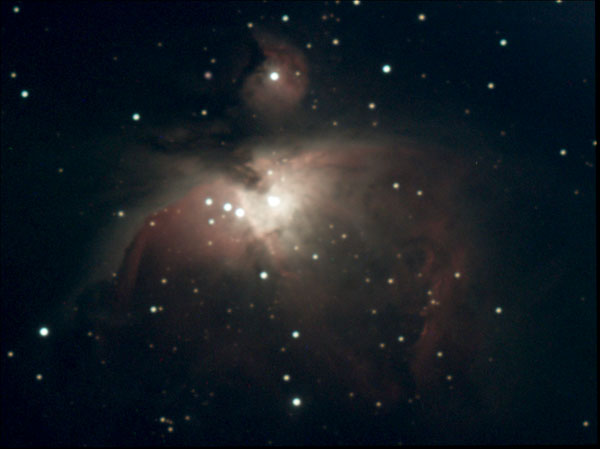
M 42/43 (16 frames, 10 s, gain 134) |
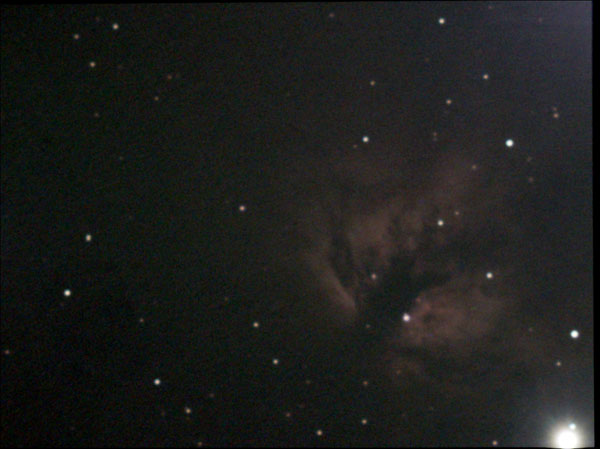
NGC 2024 (30 frames, 10 s, gain 300) |
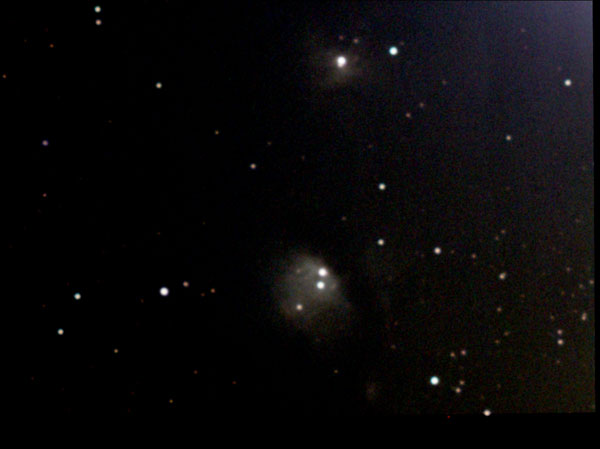
M 78 (30 frames, 10 s, gain 300) |
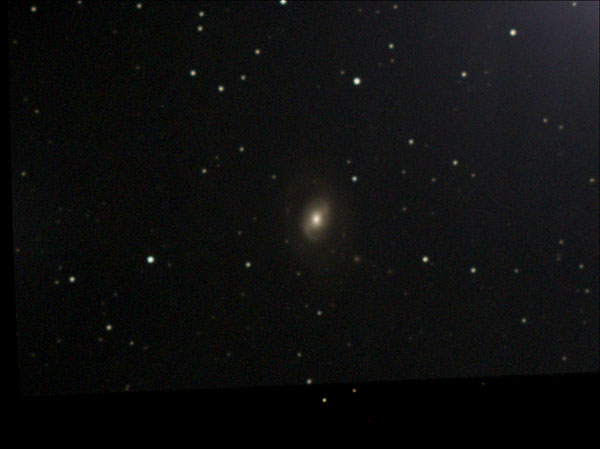
M 96 (30 frames, 10 s, gain 300) |
April 13, 2021
September 2, 2021: A Night Test with the ZWO ASI224
Note: This night test is presented in more detail on page ZWO ASI224 Color Camera - Further Experiences.
PS 72/432 on AZ-GTi with ASI224MC and UV/IR Cut Filter; selected photos:
First Conclusions
After overcoming some initial obstacles and problems, which were mainly caused by an unfavorable interaction of zenith mirror, 2" to 1.25" adapter and my eyepieces, I managed to establish a "workable" configuration with a simpler zenith mirror, in which even my triple focus extender plays a role (and, with it, my 10 mm eyepiece). Unfortunately, the Sky-Watcher adapter from 2" to 1.25" does not sit safely in the 2" eyepiece holder, so that, back from vacation, I bought a 2" zenith mirror with a corresponding adapter to 1.25". This sits firmly in the eyepiece holder, so that I have no problems with it. For terrestrial observations, I also purchased a 2" Amici prism that adapts to 1.25".
If I can focus the image, which is sometimes a bit difficult, I get very satisfying results: Stars are nicely dot-shaped, details on the moon well resolved (better than on the Heritage 100P), and I see deep sky objects almost as well (or as well) as in the Heritage 100P. In the meantime, I have been able to observe quite a number of DSOs with the PS 72/432, particularly on our autumn vacation in 2018 and in winter 2018/19.
The feared-for color fringes may be present, but they do not bother me up to now. Their extent depends certainly on the observation subject and the magnification used. In addition, they become the smaller, the more exactly one focuses. In the meantime, I have found visually yellow and photographically blue color fringes on the moon, especially at the edges.
Shortcomings are, in my opinion, (1) the missing viewfinder shoe, which I work around at the moment with a Rigel finder that is glued to the tube (in the meantime, I have two finder shoes...) and a "rubber band construction," and (2) the helical focuser. The latter is quite stiff, especially the fine adjustment ring. Sometimes, the focuser seems to lose "orientation," and I have to start focusing all over again. With the coarse adjustment, the rubber armoring sometimes seems to slip (or the focuser itself slips...). I also found a distinct hysteresis in the fine focuser, which makes focusing accurately nerve-straining. After contacting the dealer, I received a return note and returned the telescope for exchange or repair. After some time, I was notified that the telescope was "within the tolerances" and whether I wanted it back or a voucher instead. I was disappointed by this result, but decided to have the telescope returned because it seemed too cumbersome to me to exchange it for another model, given the work that I had already invested in the telescope. The telescope arrived in mid-November 2018, and shortly after, I already took a lot of satisfying photos of the moon.
First, I mainly used the Sky-Watcher AZ Pronto mount for pure manual visual observing with the PS 72/432. I upgraded this mount to a GoTo mount in early 2021 by purchasing an AZ-GTi mount head. This then also opened up the possibility of doing EAA with the PS 72/432.
In spring 2021, I operated the Atik Infinity camera on the PS 72/432 for the first time - with mixed success. The mount used was the Sky-Watcher AZ-GTi mount, which carried the telescope well (I recommend using the center column to avoid that the tube hits the tripod legs). I have tried the additionally purchased wedge only for a few times, and cannot yet comment on it. I also tested the newly acquired ZWO ASI224 camera at this telescope in 2021, again with mixed success. In April 2022, I exchanged the camera for an ASI294MC camera, which has a field of view of 2.5° x 1.7° at this refractor, so it already allows rich-field observations. I have controled the equipment with the StellarMate astronomy computer (EAA) and so far received only unsatisfactory image results (which is mainly due to the poor live stacking of the StellarMate). See page Ikarus StellarMate Plus - Further Experiences for photos taken with the ZWO ASI294MC (April 2022) and the Atik Infinity (May 2022).
Competition...
In the summer of 2020, I purchased a three-lens TS-Optics TLAPO1027 (4", 714 mm) refractor and then compared it with the ED refractor PS 72/432. These tests are described on the page for the TLAPO 1027. Daytime tests showed a clear superiority of the TLAPO1027 over the PS 72/432. I have not yet had many opportunities to try out the TLAPO1027 at night, but so far its images have looked superior in this case as well. With a camera attached, the results also look better. In particular, the stars are less "bloated" than with the PS 72/432*.
*) With a Baader UV/IR cut filter I can reduce the bloating of the stars for the PS 72/432. For the TLAPO 1027, such a filter does not seem to be necessary.
Links
- Omegon Apochromatic refractor Pro APO AP Photography Scope 72/432 ED OTA (Astroshop.eu): www.astroshop.eu/telescopes/omegon-apochromatic-refractor-pro-apo-ap-photography-scope-72-432-ed-ota/p,33081
- Omegon Apochromatischer Refraktor Photography Scope 72/432 ED (Test report by Thomas Gade): www.photoinfos.com/astronomie/Omegon-photography-scope-72-432-ed.htm (in German)
- See also my page offering Astronomy Links.
Appendix: Data for Omegon Refractor 72/432
Technical Data
| Telescope: Omegon | PS 72/432 |
| Optical Design | Refractor |
| Aperture | 72 mm |
| Focal Length, Focal Ratio | 432 mm, f/6 |
| Resolving Power (arc secs) | 1.61" ** |
| Limiting Visual Stellar Magnitude | 11.1 mag ** |
| Light Gathering Power | 105.8 ** |
| Maximum Practical Visual Power | 144 x |
| Optical Tube Dimensions (diam. x length) | 10 cm x 39.5 cm |
| Net Weight Basis | n.a. |
| Net Weight Optical Tube | 2.06 kg |
| Net Weight Complete | n.a. |
Dark Blue: Telescopes that I still own; italic and dark red: telescopes that I owned; black: for comparison; *) own measurement; **) corrected values
See also the table of data for all of my telescopes (and a few more...)
Observation-Relevant Data (in Comparison with ST120, TLAPO1027, TLAPO804, and My Ex-Newton Tube)
| Telescope | Focal |
Aperture (mm) |
Focal Ratio |
Light Gathering Power |
Maximum+ |
Minimum* |
Maximum* |
Minimum+ |
|||||
Usable Magnification |
Usable Focal
Length of Eyepiece (mm) |
||||||||||||
Factor/Exit Pupil (mm) > |
Manuf. |
1.5 |
2 |
6.5 |
7 |
6.5 |
7 |
1.5 |
2 |
||||
| PS 72/432 | 432 |
72 |
6 |
106 |
144 |
108 |
144 |
11.08 |
10.29 |
39.0 |
42.0 |
4.0 |
3.0 |
| ST120 | 600 |
120 |
5 |
290 |
180 |
240 |
18.46 |
17.14 |
32.5 |
35.0 |
3.3 |
2.5 |
|
| TLAPO804 | 480 |
80 |
6 |
130.6 |
120 | 160 | 12.31 | 11.43 | 39.0 |
42.0 |
4.0 |
3.0 |
|
| TLAPO1027 | 714 |
102 |
7 |
212.3 |
153 |
204 |
15.69 |
14.57 |
45.5 |
49.0 |
4.7 |
3.5 |
|
| Explorer PDS150/Dobson 6" | 750 |
150
|
5 |
459 |
225 |
300 |
23.08 |
21.43 |
32.5 |
35.0 |
3.3 |
2.5 |
|
*) Calculated for an exit pupil of 6.5 mm and 7 mm
+) Factor 1.5 or 2 for Dobsonian/Newtonian telescopes; in general, the lower
value of 1.5 is used for Newtonian telescopes; if the manufacturer specified
a different magnification, it is also listed (some manufacturer provide considerably
higher numbers...).
Visual Power (Magnification) and Other Data for Different Focal Lengths of Eyepieces (Mostly My Current Eyepieces)
Note: These tables include the StarTravel 120 refractor, a TSWA32 eyepiece (2", 32 mm focal length, 70° viewing angle) that I borrowed together with the StarTravel 120, a 18 mm eyepiece (2", 82° viewing angle), a 38 mm eyepiece (2", 70° viewing angle), and a 56 mm eyepiece (2", 52° viewing angle).
| Magnification | Focal Length of Eyepiece (mm) |
|||||||||||||||
| Telescope | Focal Length of Telescope (mm) |
4 |
7 |
10 |
16 |
18 |
24 |
26 |
32 |
32 |
35 |
38 |
40 |
56 |
||
| PS 72/432 | 432 |
108.00 |
61.71 |
43.20 |
27.00 |
24.00 |
18.00 |
16.62 |
13.50 |
13.50 |
12.34 |
11.37 |
10.80 |
7.71 |
||
| ST120 | 600 |
150.00 |
85.71 |
60.00 |
37.50 |
33.33 |
25.00 |
23.08 |
18.75 |
18.75 |
17.14 |
15.79 |
15.00 |
10.71 |
||
| TLAPO804 | 480 |
125.00 |
68.57 |
48.00 |
30.00 |
26.67 |
20.00 |
18.46 |
15.00 |
15.00 |
13.71 |
12.63 |
12.00 |
8.57 |
||
| TLAPO1027 | 714 |
178.50 |
102.00 |
71.40 |
44.63 |
39.67 |
29.75 |
27.46 |
22.31 |
22.31 |
20.40 |
18.79 |
17.85 |
12.75 |
||
| 150PDS | 750 |
187.50 |
107.14 |
75.00 |
46.88 |
41.67 |
31.25 |
28.85 |
23.44 |
23.44 |
21.43 |
19.74 |
18.75 |
13.39 |
||
| SM127 | 1500 |
375.00 |
214.29 |
150.00 |
93.75 |
--- |
62.50 |
--- |
46.88 |
--- |
--- |
--- |
--- |
--- |
||
| SM102 | 1300 |
325.00 |
185.71 |
130.00 |
81.25 |
--- |
54.17 |
--- |
40.63 |
--- |
--- |
--- |
--- |
--- |
||
| C5 | 1250 |
312.50 |
178.57 |
125.00 |
78.13 |
--- |
52.08 |
--- |
39.06 |
39.06 |
35.71 |
32.89 |
31.25 |
22.32 |
||
| C5 (Red.) | 787.5 |
196.88 |
112.50 |
78.75 |
49.22 |
--- |
32.81 |
--- |
24.61 |
--- |
--- |
--- |
--- |
--- |
||
| C8 | 2032 |
508.00 |
290.29 |
203.20 |
127.00 |
112.89 |
84.67 |
78.15 |
63.50 |
63.50 |
58.06 |
53.47 |
50.80 |
36.29 |
||
| C8 (Red.) | 1280 |
320.00 |
182.86 |
128.00 |
80.00 |
--- |
53.33 |
--- |
40.00 |
--- |
--- |
--- |
--- |
--- |
||
| True Field of View (°) | Focal Length of Eyepiece (mm) |
Camera |
||||||||||||||
Apparent FOV (°) > |
82 |
82 |
72 |
82 |
82 |
65 |
70 |
52 |
70 |
69 |
70 |
68 |
52 |
ZWO |
Atik |
|
| Telescope | Focal Length of Telescope (mm) |
4 |
7 |
10 |
16 |
18 |
24 |
26 |
32 |
32 |
35 |
38 |
40 |
56 |
ASI294 |
Infinity |
| PS 72/432 | 432 |
0.76 |
1.33 |
1.67 |
3.04 |
3.42 |
3.61 |
4.21 |
3.85 |
5.19 |
5.59 |
6.16 |
6.30 |
6.74 |
2.54° x 1.73° | 1.19° x 0.89° |
| ST120 | 600 |
0.55 |
0.96 |
1.20 |
2.19 |
2.46 |
2.60 |
3.03 |
2.77 |
3.73 |
4.03 |
4.43 |
4.53 |
4.85 |
||
| TLAPO804 | 480 |
0.68 |
1.20 |
1.50 |
2.73 |
3.08 |
3.25 |
3.79 |
3.47 |
4.67 |
5.03 |
5.54 |
5.67 |
6.07 |
2.29° x 1.56° | |
| TLAPO1027 | 714 |
0.46 |
0.80 |
0.91 |
1.84 |
2.07 |
2.18 |
2.55 |
2.33 |
3.14 |
3.38 |
3.73 |
3.92 |
4.08 |
1.54° x 1.05° | 0.72° x 0.54° |
| 150PDS | 750 |
0.44 |
0.77 |
0.96 |
1.75 |
1.97 |
2.08 |
2.43 |
2.22 |
2.99 |
3.22 |
3.55 |
3.63 |
3.88 |
||
| SM127 | 1500 |
0.22 |
0.38 |
0.48 |
0.87 |
--- |
1.04 |
--- |
1.11 |
--- |
--- |
--- |
--- |
--- |
||
| SM102 | 1300 |
0.25 |
0.44 |
0.55 |
1.01 |
--- |
1.20 |
--- |
1.28 |
--- |
--- |
--- |
--- |
--- |
||
| C5 | 1250 |
0.26 |
0.46 |
0.58 |
1.05 |
--- |
1.25 |
--- |
1.33 |
1.79 |
1.93 |
2.13 |
2.18 |
2.33 |
0.88° x 0.60° | 0.41° x 0.31° |
| C5 (Red.) | 787.5 |
0.42 |
0.73 |
0.91 |
1.67 |
--- |
1.98 |
--- |
2.11 |
--- |
--- |
--- |
--- |
--- |
1.40° x 0.95° | 0.65° x 0.49° |
| C8 | 2032 |
0.16 |
0.28 |
0.35 |
0.65 |
0.73 |
0.77 |
0.90 |
0.82 |
1.10 |
1.19 |
1.31 |
1.34 |
1.43 |
0.54° x 0.37° | 0.25° x 0.19° |
| C8 (Red.) | 1280 |
0.26 |
0.45 |
0.63 |
1.03 |
--- |
1.22 |
--- |
1.30 |
--- |
--- |
--- |
--- |
--- |
0.86° x 0.58° | 0.4° x 0.3° |
| Exit Pupil (mm) | Focal Length of Eyepiece (mm) |
|||||||||||||||
| Telescope | Focal Ratio |
4 |
7 |
10 |
16 |
18 |
24 |
26 |
32 |
32 |
35 |
38 |
40 |
56 |
||
| PS 72/432 | 6 |
0.67 |
1.17 |
1.67 |
2.67 |
3.00 |
4.00 |
4.33 |
5.33 |
5.33 |
5.83 |
6.33 |
6.67 |
9.33 |
||
| ST120 | 5 |
0.80 |
1.40 |
2.00 |
3.20 |
3.60 |
4.80 |
5.20 |
6.40 |
6.40 |
7.00 |
7.60 |
8.00 |
11.20 |
||
| TLAPO804 | 6 |
0.67 |
1.17 |
1.67 |
2.67 |
3.00 |
4.00 |
4.33 |
5.33 |
5.33 |
5.83 |
6.33 |
6.67 |
9.33 |
||
| TLAPO1027 | 7 |
0.57 |
1.00 |
1.43 |
2.29 |
2.57 |
3.43 |
3.71 |
4.57 |
4.57 |
5.00 |
5.43 |
5.71 |
8.00 |
||
| 150PDS | 5 |
0.80 |
1.40 |
2.00 |
3.20 |
3.60 |
4.80 |
5.20 |
6.40 |
6.40 |
7.00 |
7.60 |
8.00 |
11.20 |
||
| SM127 | 11.81 |
0.34 |
0.59 |
0.85 |
1.35 |
--- |
2.03 |
--- |
2.71 |
--- |
--- |
--- |
--- |
--- |
||
| SM102 | 12.75 |
0.31 |
0.55 |
0.78 |
1.26 |
--- |
1.88 |
--- |
2.51 |
--- |
--- |
--- |
--- |
--- |
||
| C5 | 10 |
0.40 |
0.70 |
1.00 |
1.60 |
--- |
2.40 |
--- |
3.20 |
3.20 |
3.50 |
3.80 |
4.00 |
5.60 |
||
| C5 (Red.) | 6.3 |
0.63 |
1.11 |
1.59 |
2.54 |
--- |
3.81 |
--- |
5.08 |
--- |
--- |
--- |
--- |
--- |
||
| C8 | 10 |
0.40 |
0.70 |
1.00 |
1.60 |
1.80 |
2.40 |
2.60 |
3.20 |
3.20 |
3.50 |
3.80 |
4.00 |
5.60 |
||
| C8 (Red.) | 6.3 |
0.63 |
1.11 |
1.59 |
2.54 |
--- |
3.81 |
--- |
5.08 |
--- |
--- |
--- |
--- |
--- |
||
Blue: Equipment borrowed for comparison purposes; gray: sold equipment; italic: 2" eyepieces
Magnification: Yellow: low (30-50 x); magenta: medium
(80-100 x); violet: high (150-200 x - and more); red: beyond
maximum usable magnification.
Exit pupil: Values in magenta cells are
either too small (< 1 mm) or too large (> 6.4/7 mm); yellow background:
best for galaxies (about 2-3 mm).
Recommendations for the Focal Lengths of Eyepieces for PS72 (Following My Recommendations and Those of Others)
| Criteria | Exit Pupil |
Focal
Length of Eyepiece |
|||||
| Category | Application Area | from...to |
Calculated |
On the Market |
Examples |
Existing |
|
| Maximum FOV | Search | 7 |
10 |
42-60 |
40-56* |
40...56* |
40 |
| Minimum Magnification / Large FOV | Overview, large-area nebulae | 4.5 |
6.5 |
27-39 |
28-38* |
28...38* |
26, 35 |
| Normal Magnification | Large-area, faint nebulae; nebulae, open star clusters | 3.5 |
4 |
21-24 |
20-25* |
20...25 |
24, 26 |
| Best for many objects, e.g. for most galaxies, and mid-size DSO | 2 |
3 |
12-18 |
12-18* |
12, 15, 16, 18 |
16 |
|
| Maximum Magnification / Maximum Resolution | "Normal" upper magnification limit; globular star clusters | 1 |
1.5 |
6-9 |
6-9 |
6, 7, 9 |
7, 10 |
| Maximum perceptibility of small, low-contrast
details; planetary nebulae, small galaxies; maximum magnification for moon and planets |
0.6 |
0.8 |
3.5-5 |
3.5-5 |
4 |
4 |
|
| Separation of narrow double stars, small planetary
nebulae; perception of faintest details |
0.4 |
0.5 |
2.4-3 |
2.5-3 |
3 |
--- |
|
*) Partly available as 2" eyepiece; **) typically no suitable 1,25" eyepieces available; problems with viewing at 40 mm; italic: not possible; red: magnification too high; blue: commercial focal lengths
| 27.11.2024 |
